
What are the most interesting vacuum tubes in your collection?
radhoo, Sat Feb 19 2011, 09:51AMEven if they are considered obsolete by some, the vacuum tubes still provide interesting applications, and in some cases are irreplaceable by silicon.
I hope that other members will join and contribute, based on their experience and knowledge.
I suggest we build this thread, to contain the best of our tube collections, like a virtual museum, if you want.
If possible, please try to upload quality photos, that others would enjoy seeing.
Also based on your knowledge it would be great to include a few words on the purpose of the vacuum tube pictured. This way we all get to learn something. So here it goes:
Re: What are the most interesting vacuum tubes in your collection?
radhoo, Sat Feb 19 2011, 09:54AM
Transmitting Triode 710A (200W, 600MHz max)
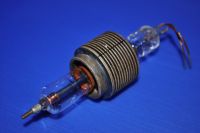
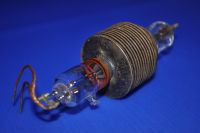

More details available here:


radhoo, Sat Feb 19 2011, 09:54AM
Transmitting Triode 710A (200W, 600MHz max)



More details available here:


Re: What are the most interesting vacuum tubes in your collection?
Proud Mary, Sat Feb 19 2011, 12:20PM
EF97 - low voltage variable-mu pentode
So why this modest looking valve instead of the usual 4HV power porn?
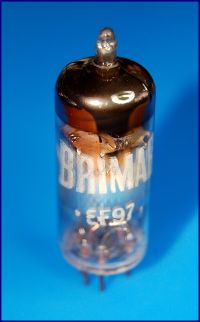
EF97 was designed to be fully functional with an anode voltage of as little as 6.3V, with the screen grid at a tiny 3.2V.
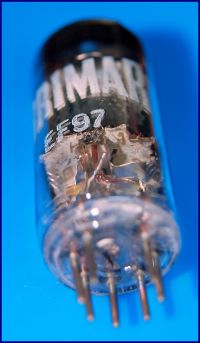
EF97 ran directly from a car battery, and so did away with the need for costly HV batteries, vibrating reed invertors, or dynamotors usually required to supply anode voltage to car radio reciever valves.
Its heyday in car radios and record players was shortlived. Manufacture began in 1958 and had ended by the mid-60s, a period of radical transition in the electronics industry. The Thermionic Age was coming to an end, and the Solid State Age had just begun, so EF97 and its fellow car radio valves were quickly forgotten when germanium transistors began to appear in commercial designs.
But for the experimenter, the car radio valve remains an easy way of getting into thermionic technology without the danger of electric shock, or the need for specially built smoothed HT power supplies.
Some, but not all, of the car radio valves worked in space charge grid mode. In these valves, such as 12K5, g1 is designated as 'space charge grid' and held positive as an electron accelerator, while g2 - normally the screen grid - is designated as 'control grid.' Check the data sheets to avoid mis-wiring.
There are plenty of 'space charge tube' circuits to be found on Google.

Proud Mary, Sat Feb 19 2011, 12:20PM
EF97 - low voltage variable-mu pentode
So why this modest looking valve instead of the usual 4HV power porn?

EF97 was designed to be fully functional with an anode voltage of as little as 6.3V, with the screen grid at a tiny 3.2V.

EF97 ran directly from a car battery, and so did away with the need for costly HV batteries, vibrating reed invertors, or dynamotors usually required to supply anode voltage to car radio reciever valves.
Its heyday in car radios and record players was shortlived. Manufacture began in 1958 and had ended by the mid-60s, a period of radical transition in the electronics industry. The Thermionic Age was coming to an end, and the Solid State Age had just begun, so EF97 and its fellow car radio valves were quickly forgotten when germanium transistors began to appear in commercial designs.
But for the experimenter, the car radio valve remains an easy way of getting into thermionic technology without the danger of electric shock, or the need for specially built smoothed HT power supplies.
Some, but not all, of the car radio valves worked in space charge grid mode. In these valves, such as 12K5, g1 is designated as 'space charge grid' and held positive as an electron accelerator, while g2 - normally the screen grid - is designated as 'control grid.' Check the data sheets to avoid mis-wiring.
There are plenty of 'space charge tube' circuits to be found on Google.

Re: What are the most interesting vacuum tubes in your collection?
radhoo, Sat Feb 19 2011, 03:51PM
714 7021 Gas and Mercury Thyratron.
A thyratron is a type of gas filled tube used as a high energy electrical switch and controlled rectifier.
I might try one of these in a small SG tesla coil, as a spark gap replacement.

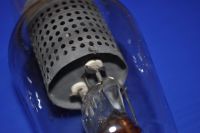

The datasheet, as PDF: ]714_7021.pdf[/file]
radhoo, Sat Feb 19 2011, 03:51PM
714 7021 Gas and Mercury Thyratron.
A thyratron is a type of gas filled tube used as a high energy electrical switch and controlled rectifier.
I might try one of these in a small SG tesla coil, as a spark gap replacement.



The datasheet, as PDF: ]714_7021.pdf[/file]
Re: What are the most interesting vacuum tubes in your collection?
Finn Hammer, Sat Feb 19 2011, 09:04PM
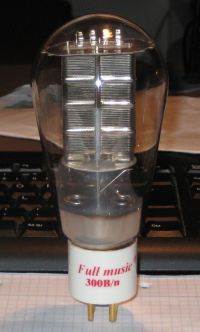
300B is an audio power triode, here in a recent version with globe shaped envelope.
Audio lore (or hype if you wish) has it that the globe shaped tubes sounded better, thus there was a market for this variety.
What I find interesting about this valve, is that it has acheived cult status amongst audiophiles, and therefore can be sold at prices that are much higher than that charged for even bigger valves.
That's the way it is amongst audiophiles.
Cheers, Finn Hammer
Finn Hammer, Sat Feb 19 2011, 09:04PM

300B is an audio power triode, here in a recent version with globe shaped envelope.
Audio lore (or hype if you wish) has it that the globe shaped tubes sounded better, thus there was a market for this variety.
What I find interesting about this valve, is that it has acheived cult status amongst audiophiles, and therefore can be sold at prices that are much higher than that charged for even bigger valves.
That's the way it is amongst audiophiles.
Cheers, Finn Hammer
Re: What are the most interesting vacuum tubes in your collection?
radhoo, Sun Feb 20 2011, 11:13AM
Reflex Klystron 6236, with a frequency range of 3.8 to 7.6 GHz with 125mW output.
Klystrons are used as amplifiers at microwave and radio frequencies to produce both low-power reference signals for superheterodyne radar receivers and to produce high-power carrier waves for communications and the driving force for modern particle accelerators.
This tube was used by the military, judging by the output power it probably functioned in a RF generator.
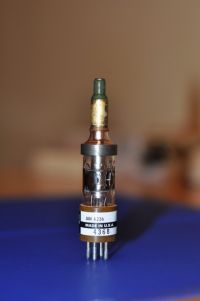


A circuit using this klystron:
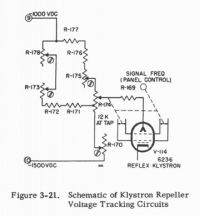
Taken from:
Wish I had more data on it.
radhoo, Sun Feb 20 2011, 11:13AM
Reflex Klystron 6236, with a frequency range of 3.8 to 7.6 GHz with 125mW output.
Klystrons are used as amplifiers at microwave and radio frequencies to produce both low-power reference signals for superheterodyne radar receivers and to produce high-power carrier waves for communications and the driving force for modern particle accelerators.
This tube was used by the military, judging by the output power it probably functioned in a RF generator.



A circuit using this klystron:

Taken from:

Wish I had more data on it.
Re: What are the most interesting vacuum tubes in your collection?
Bored Chemist, Sun Feb 20 2011, 01:39PM
I don't collect tubes, but I have a dead 3CX1500D3 I use as a paper weight.
Bored Chemist, Sun Feb 20 2011, 01:39PM
I don't collect tubes, but I have a dead 3CX1500D3 I use as a paper weight.
Re: What are the most interesting vacuum tubes in your collection?
radhoo, Sun Feb 20 2011, 02:33PM
radhoo, Sun Feb 20 2011, 02:33PM
Bored Chemist wrote ...
I don't collect tubes, but I have a dead 3CX1500D3 I use as a paper weight.
Would you post a photo?I don't collect tubes, but I have a dead 3CX1500D3 I use as a paper weight.
Re: What are the most interesting vacuum tubes in your collection?
Wolfram, Mon Feb 21 2011, 12:55PM
These are about half of them. The biggest tube in the first photo is the same size as the smallest one in the second
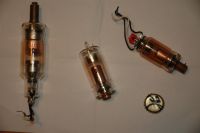

Wolfram, Mon Feb 21 2011, 12:55PM
These are about half of them. The biggest tube in the first photo is the same size as the smallest one in the second


Re: What are the most interesting vacuum tubes in your collection?
Steve Conner, Mon Feb 21 2011, 01:05PM

I have lots of other tubes, but this one is most in the "4HV Power Porn" spirit. I would like to build a RF amp with it some day.
Finn, are you still using that beautiful 300B hi-fi amp I saw when I visited you in Denmark?
Steve Conner, Mon Feb 21 2011, 01:05PM

I have lots of other tubes, but this one is most in the "4HV Power Porn" spirit. I would like to build a RF amp with it some day.
Finn, are you still using that beautiful 300B hi-fi amp I saw when I visited you in Denmark?
Re: What are the most interesting vacuum tubes in your collection?
Finn Hammer, Mon Feb 21 2011, 08:56PM
You mean this one:
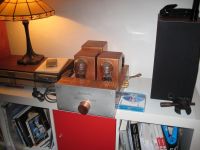
Sure!

 Cheers, Finn Hammer
Cheers, Finn Hammer 

Finn Hammer, Mon Feb 21 2011, 08:56PM
Steve McConner wrote ...
Finn, are you still using that beautiful 300B hi-fi amp I saw when I visited you in Denmark?
Finn, are you still using that beautiful 300B hi-fi amp I saw when I visited you in Denmark?
You mean this one:


Sure!


 Cheers, Finn Hammer
Cheers, Finn Hammer 

Re: What are the most interesting vacuum tubes in your collection?
radhoo, Mon Feb 21 2011, 11:16PM
Nice one, Finn!
Anders, that's an impressive collection of x-ray tubes! Did you find a gold mine with X-ray tubes somewhere?
Another tube, a voltage regulator, Sylvania VR150 :
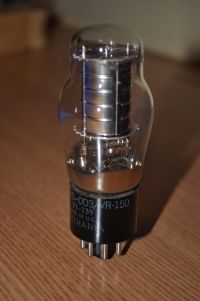
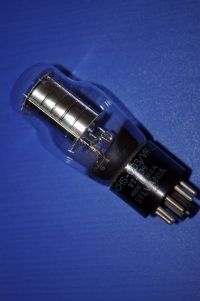
radhoo, Mon Feb 21 2011, 11:16PM
Nice one, Finn!
Anders, that's an impressive collection of x-ray tubes! Did you find a gold mine with X-ray tubes somewhere?
Another tube, a voltage regulator, Sylvania VR150 :


Re: What are the most interesting vacuum tubes in your collection?
Proud Mary, Wed Feb 23 2011, 08:07PM
For anyone suffering from indigestion after Anders' medical monstrosities above, here at last is the low fat X-ray tube you can use between meals!
The micro-focus transmission target BS-7 thrives on a calorie-conscious 20mW, works across 5kV - 15kV in grounded anode mode, and needs just 1.2V on the filament, a perfect match for NiMH cells.
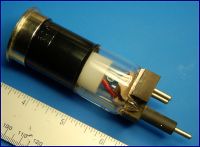
BS-7 has a focal spot of just 0.0017mm, and the beryllium exit window passes X-rays down to 5keV, perfect for the girl who wants to image a mosquito's wing.
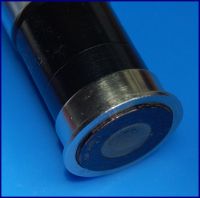
The transmission target is a tungsten nanolayer, so this is a tube which will fail almost at once if its tiny dissipation rating is exceeded.
Proud Mary, Wed Feb 23 2011, 08:07PM
For anyone suffering from indigestion after Anders' medical monstrosities above, here at last is the low fat X-ray tube you can use between meals!
The micro-focus transmission target BS-7 thrives on a calorie-conscious 20mW, works across 5kV - 15kV in grounded anode mode, and needs just 1.2V on the filament, a perfect match for NiMH cells.

BS-7 has a focal spot of just 0.0017mm, and the beryllium exit window passes X-rays down to 5keV, perfect for the girl who wants to image a mosquito's wing.

The transmission target is a tungsten nanolayer, so this is a tube which will fail almost at once if its tiny dissipation rating is exceeded.
Re: What are the most interesting vacuum tubes in your collection?
Mads Barnkob, Wed Feb 23 2011, 08:43PM
This is my one of my favourite tubes in my collection, its a nice fat boy capable of outputting 3kW :)
The QB5/2000

Mads Barnkob, Wed Feb 23 2011, 08:43PM
This is my one of my favourite tubes in my collection, its a nice fat boy capable of outputting 3kW :)
The QB5/2000

Re: What are the most interesting vacuum tubes in your collection?
radhoo, Thu Feb 24 2011, 08:15PM
The ancestor of CCD sensors, here is an Amperex 8483 Vidicon (Video Camera) tube. These devices, similar to the CRT , where capable of transforming an image into an electrical signal!
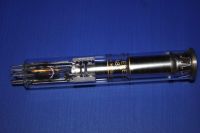
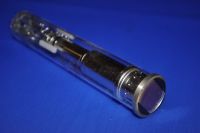
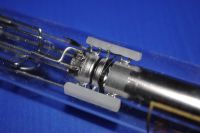
wikipedia page here:
radhoo, Thu Feb 24 2011, 08:15PM
The ancestor of CCD sensors, here is an Amperex 8483 Vidicon (Video Camera) tube. These devices, similar to the CRT , where capable of transforming an image into an electrical signal!



wikipedia page here:

Re: What are the most interesting vacuum tubes in your collection?
Steve Conner, Sat Feb 26 2011, 09:26PM
Finn, yep, that's the one. I finally got round to building one too. Couldn't dumpster dive any 300Bs, so KT88s had to do.
It's push-pull and about 30W per channel.
The GEC KT88s in there are some of the most interesting tubes in my collection, too. I got 6 from two scrapped Brandenburg power supplies, and a seventh one was given to me by a friend. Out of that lot I was able to make two matched pairs.
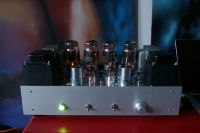
Steve Conner, Sat Feb 26 2011, 09:26PM
Finn, yep, that's the one. I finally got round to building one too. Couldn't dumpster dive any 300Bs, so KT88s had to do.

It's push-pull and about 30W per channel.
The GEC KT88s in there are some of the most interesting tubes in my collection, too. I got 6 from two scrapped Brandenburg power supplies, and a seventh one was given to me by a friend. Out of that lot I was able to make two matched pairs.

Re: What are the most interesting vacuum tubes in your collection?
Nah, Mon Feb 28 2011, 11:40PM
You guys have all the fun, I only have $100 globe radio tubes. Eye tubes anyone?:-(
Nah, Mon Feb 28 2011, 11:40PM
You guys have all the fun, I only have $100 globe radio tubes. Eye tubes anyone?:-(
Re: What are the most interesting vacuum tubes in your collection?
radhoo, Tue Mar 01 2011, 10:33AM
MA340F, I don't know much about this tube (still need to get Sibley's Tube Lore), but I think it was used in a radar after the WW2:
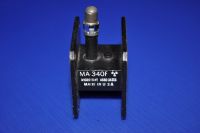

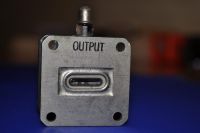
This tube is marked as radioactive, probably it was manufactured with a tiny amount of Cesium 137, but today it shows no radioactivity.
LE: " ... a TR cell, a device used to protect the receiver portion of a microwave transceiver which shares the same antenna for both transmit and receive functions. A TR cell functions like a triggered gap tube, and blocks the receiver hardware by shorting the receiver input during transmitter operation. Transmitter pulses cause the spark gap to break down, shorting the receiver input. "
radhoo, Tue Mar 01 2011, 10:33AM
MA340F, I don't know much about this tube (still need to get Sibley's Tube Lore), but I think it was used in a radar after the WW2:



This tube is marked as radioactive, probably it was manufactured with a tiny amount of Cesium 137, but today it shows no radioactivity.
LE: " ... a TR cell, a device used to protect the receiver portion of a microwave transceiver which shares the same antenna for both transmit and receive functions. A TR cell functions like a triggered gap tube, and blocks the receiver hardware by shorting the receiver input during transmitter operation. Transmitter pulses cause the spark gap to break down, shorting the receiver input. "
Re: What are the most interesting vacuum tubes in your collection?
Nicko, Tue Mar 01 2011, 04:27PM
I don't normally get my tubes out in public, but here's something you won't see very often - a CK1414-07 "Symbolray" character generation tube (sometimes called a "monoscope" but not a "charactron" - that was something else [but similar]).
The CK1414s series were used to generate characters & symbols for RADAR & other systems - they contain a scanning electron gun (electrostatic deflection) and a symbol mask with an output collector. The -07 suffix determines the mask that's in this tube - I've never seen another "-07" variant... It's a beast - about a foot long...
Edit: I should point out that the mask could be whatever you wanted - e.g. a test card for a quiesced TV channel or a message "Normal service will be resumed soon" for a studio problem, or even the outline of an airfield for a radar overlay...
Each tube has an individual serial number - mine is NIB and came in a job lot of otherwise uninteresting junk...
]ck1414.pdf[/file] (if you read the end of the datasheet it explains how it works - very cunning!)
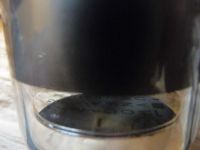

Nicko, Tue Mar 01 2011, 04:27PM
I don't normally get my tubes out in public, but here's something you won't see very often - a CK1414-07 "Symbolray" character generation tube (sometimes called a "monoscope" but not a "charactron" - that was something else [but similar]).
The CK1414s series were used to generate characters & symbols for RADAR & other systems - they contain a scanning electron gun (electrostatic deflection) and a symbol mask with an output collector. The -07 suffix determines the mask that's in this tube - I've never seen another "-07" variant... It's a beast - about a foot long...
Edit: I should point out that the mask could be whatever you wanted - e.g. a test card for a quiesced TV channel or a message "Normal service will be resumed soon" for a studio problem, or even the outline of an airfield for a radar overlay...
Each tube has an individual serial number - mine is NIB and came in a job lot of otherwise uninteresting junk...
]ck1414.pdf[/file] (if you read the end of the datasheet it explains how it works - very cunning!)


Re: What are the most interesting vacuum tubes in your collection?
radhoo, Tue Mar 01 2011, 04:43PM
Nice one, Nicko!
radhoo, Tue Mar 01 2011, 04:43PM
Nice one, Nicko!
Re: What are the most interesting vacuum tubes in your collection?
radhoo, Tue Mar 01 2011, 09:19PM
Here's a rare one, an electrometer tube, used in pH-meters, the 932 Lewis & Kaufman Electrometer:
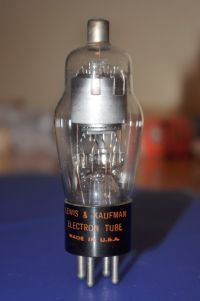
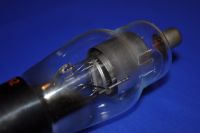
Primarily invented and designed for the California Citrus industry to determine when the fruit was ready to pick. Juicy!
radhoo, Tue Mar 01 2011, 09:19PM
Here's a rare one, an electrometer tube, used in pH-meters, the 932 Lewis & Kaufman Electrometer:


Primarily invented and designed for the California Citrus industry to determine when the fruit was ready to pick. Juicy!

Re: What are the most interesting vacuum tubes in your collection?
Proud Mary, Wed Mar 02 2011, 03:42PM
High Power Demountable Micro-Focus Soft X-Ray Source
500eV - 5keV.
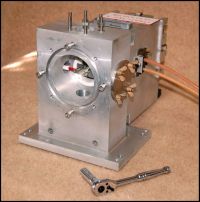
Anode end from which beam emerges. Water cooling hoses at right.

Coaxial HV input socket.
Note optical inspection port for gas plasma observation and spectroscopy.

A titanium target is currently held to the ceramic mount, but any desired metal foil can be installed to produce the X-ray spectrum of choice.
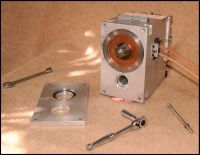
Copper water cooling jacket.
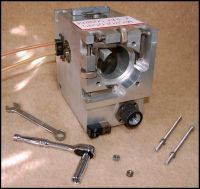
Rear View: Micrometer x-y beam alignment controls with view into Grimm discharge hollow cathode.
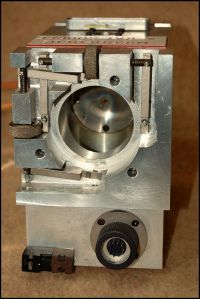
Rear View: Note high temperature discolouration of metal around alignment hole in hollow cathode assembly.
At bottom right is a plug-in ionization-type vacuum gauge - basically a thermionic diode whose conductance depends on the depth of the vacuum.
Proud Mary, Wed Mar 02 2011, 03:42PM
High Power Demountable Micro-Focus Soft X-Ray Source
500eV - 5keV.

Anode end from which beam emerges. Water cooling hoses at right.

Coaxial HV input socket.
Note optical inspection port for gas plasma observation and spectroscopy.

A titanium target is currently held to the ceramic mount, but any desired metal foil can be installed to produce the X-ray spectrum of choice.

Copper water cooling jacket.

Rear View: Micrometer x-y beam alignment controls with view into Grimm discharge hollow cathode.

Rear View: Note high temperature discolouration of metal around alignment hole in hollow cathode assembly.
At bottom right is a plug-in ionization-type vacuum gauge - basically a thermionic diode whose conductance depends on the depth of the vacuum.
Re: What are the most interesting vacuum tubes in your collection?
plazmatron, Wed Mar 02 2011, 03:51PM
Amazing x-ray porn Stella and Anders M!
So heres some more.
A Flash x-ray tube, rated for 150kV pulse, at 60ns duration! Capable of imaging Pylon cables, and through several inches of concrete.
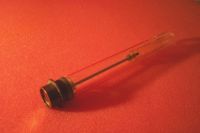
The tube is cold cathode, and is beautifully simple!
Les
plazmatron, Wed Mar 02 2011, 03:51PM
Amazing x-ray porn Stella and Anders M!
So heres some more.
A Flash x-ray tube, rated for 150kV pulse, at 60ns duration! Capable of imaging Pylon cables, and through several inches of concrete.

The tube is cold cathode, and is beautifully simple!
Les
Re: What are the most interesting vacuum tubes in your collection?
Proud Mary, Wed Mar 02 2011, 06:25PM
A very elegant device. Is there visible attrition of cathode and anode with frequent use? What are the failure modes of such a tube?
Proud Mary, Wed Mar 02 2011, 06:25PM
plazmatron wrote ...
Amazing x-ray porn Stella and Anders M!
So heres some more.
A Flash x-ray tube, rated for 150kV pulse, at 60ns duration! Capable of imaging Pylon cables, and through several inches of concrete.

The tube is cold cathode, and is beautifully simple!
Les
Amazing x-ray porn Stella and Anders M!
So heres some more.
A Flash x-ray tube, rated for 150kV pulse, at 60ns duration! Capable of imaging Pylon cables, and through several inches of concrete.

The tube is cold cathode, and is beautifully simple!
Les
A very elegant device. Is there visible attrition of cathode and anode with frequent use? What are the failure modes of such a tube?
Re: What are the most interesting vacuum tubes in your collection?
radhoo, Thu Mar 03 2011, 11:51PM
935 from RCA, a Photocell tube:
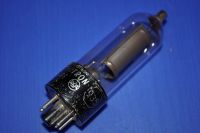

This old device probably goes back to 1935.
It was used in old movie sound systems, as the reader.
radhoo, Thu Mar 03 2011, 11:51PM
935 from RCA, a Photocell tube:


This old device probably goes back to 1935.
It was used in old movie sound systems, as the reader.
Re: What are the most interesting vacuum tubes in your collection?
Proud Mary, Fri Mar 04 2011, 12:43AM
It would be interesting to see how it performs as an X-ray dosimeter. I've just looked at the datasheet here:

You'll see that the peak sensitivity is said to be 3400Ã… i.e. 340nm UV - which is probably the shortest wavelength that can be transmitted through the glass. It may become more sensitive still as wavelengths are shortened into the X-ray region - who can say?
If you wrap the photocell in black artist's paper or black plastic etc and then put 100 - 250V DC (whatever you have available) on the anode, and a 50μA meter in the cathode line, you might see a current flow when you place it close to the 2X2A or your new dental tube. Definitely worth a try!
Proud Mary, Fri Mar 04 2011, 12:43AM
radhoo wrote ...
935 from RCA, a Photocell tube:


This old device probably goes back to 1935.
It was used in old movie sound systems, as the reader.
935 from RCA, a Photocell tube:


This old device probably goes back to 1935.
It was used in old movie sound systems, as the reader.
It would be interesting to see how it performs as an X-ray dosimeter. I've just looked at the datasheet here:

You'll see that the peak sensitivity is said to be 3400Ã… i.e. 340nm UV - which is probably the shortest wavelength that can be transmitted through the glass. It may become more sensitive still as wavelengths are shortened into the X-ray region - who can say?
If you wrap the photocell in black artist's paper or black plastic etc and then put 100 - 250V DC (whatever you have available) on the anode, and a 50μA meter in the cathode line, you might see a current flow when you place it close to the 2X2A or your new dental tube. Definitely worth a try!

Re: What are the most interesting vacuum tubes in your collection?
plazmatron, Fri Mar 04 2011, 01:45PM
The anode tip cannot be seen, it is well hidden in there.
The cathode is made of carbon fibers i believe, and will eventually be damaged by impact from Tungsten atoms from the anode, but it is a slow process.
The anode will end up eroded like any other, however likewise it too is a fairly slow process. The tube warranty is 20,000 shots but MTBF is something like 1x10e6 shots
Les
plazmatron, Fri Mar 04 2011, 01:45PM
Proud Mary wrote ...
A very elegant device. Is there visible attrition of cathode and anode with frequent use? What are the failure modes of such a tube?
A very elegant device. Is there visible attrition of cathode and anode with frequent use? What are the failure modes of such a tube?
The anode tip cannot be seen, it is well hidden in there.
The cathode is made of carbon fibers i believe, and will eventually be damaged by impact from Tungsten atoms from the anode, but it is a slow process.
The anode will end up eroded like any other, however likewise it too is a fairly slow process. The tube warranty is 20,000 shots but MTBF is something like 1x10e6 shots

Les
Re: What are the most interesting vacuum tubes in your collection?
radhoo, Fri Mar 11 2011, 10:21AM
Another thyrathron tube, the 309CE FG-17:

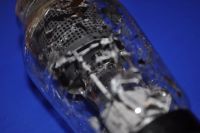
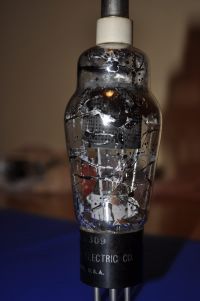
It contains mercury, as can easily be seen in the pictures, thin metallic layers deposits on all internals.
radhoo, Fri Mar 11 2011, 10:21AM
Proud Mary wrote ...
If you wrap the photocell in black artist's paper or black plastic etc and then put 100 - 250V DC (whatever you have available) on the anode, and a 50μA meter in the cathode line, you might see a current flow when you place it close to the 2X2A or your new dental tube. Definitely worth a try!
A good idea, actually this is what I purchased this tube for, I also have some other photosensitive tubes that I will try.If you wrap the photocell in black artist's paper or black plastic etc and then put 100 - 250V DC (whatever you have available) on the anode, and a 50μA meter in the cathode line, you might see a current flow when you place it close to the 2X2A or your new dental tube. Definitely worth a try!

Another thyrathron tube, the 309CE FG-17:



It contains mercury, as can easily be seen in the pictures, thin metallic layers deposits on all internals.
Re: What are the most interesting vacuum tubes in your collection?
Proud Mary, Fri Mar 11 2011, 10:48AM
I was trying to find a paper for you on the conditioning of Hg thyratrons that have been out of service and moved about for some time. I couldn't find anything with a quick search, but think I remember that the thyratron must be set up vertical, and started on very low power, to give the mercury a chance to vapourize and redistribute where it has been splashed all over the inside. If it was mine, I think I'd first heat the glass envelope with a hot air gun.
Mercury vapour thyratrons will only function correctly over a narrow ambient temperature range, so that a steady equilibrium of Hg evaporation and condensation occurs. Outside this temperature range, thermal insulation may be required if it is too cold, or forced air cooling if it is too hot. I see from the General Electric datasheet that your FG17 has an operating temperature range of +40°C to +80°C, with +40°C being recommended.
I've been too busy to do much with the 2X2A project, but hope to get back into it this weekend.
Did you see Poliţist, Adjectiv yet? I saw it last night, and thought it really very good.
Proud Mary, Fri Mar 11 2011, 10:48AM
radhoo wrote ...
Another thyrathron tube, the 309CE FG-17:



It contains mercury, as can easily be seen in the pictures, thin metallic layers deposits on all internals.
Proud Mary wrote ...
If you wrap the photocell in black artist's paper or black plastic etc and then put 100 - 250V DC (whatever you have available) on the anode, and a 50μA meter in the cathode line, you might see a current flow when you place it close to the 2X2A or your new dental tube. Definitely worth a try!
A good idea, actually this is what I purchased this tube for, I also have some other photosensitive tubes that I will try.If you wrap the photocell in black artist's paper or black plastic etc and then put 100 - 250V DC (whatever you have available) on the anode, and a 50μA meter in the cathode line, you might see a current flow when you place it close to the 2X2A or your new dental tube. Definitely worth a try!

Another thyrathron tube, the 309CE FG-17:



It contains mercury, as can easily be seen in the pictures, thin metallic layers deposits on all internals.
I was trying to find a paper for you on the conditioning of Hg thyratrons that have been out of service and moved about for some time. I couldn't find anything with a quick search, but think I remember that the thyratron must be set up vertical, and started on very low power, to give the mercury a chance to vapourize and redistribute where it has been splashed all over the inside. If it was mine, I think I'd first heat the glass envelope with a hot air gun.
Mercury vapour thyratrons will only function correctly over a narrow ambient temperature range, so that a steady equilibrium of Hg evaporation and condensation occurs. Outside this temperature range, thermal insulation may be required if it is too cold, or forced air cooling if it is too hot. I see from the General Electric datasheet that your FG17 has an operating temperature range of +40°C to +80°C, with +40°C being recommended.
I've been too busy to do much with the 2X2A project, but hope to get back into it this weekend.
Did you see Poliţist, Adjectiv yet? I saw it last night, and thought it really very good.
Re: What are the most interesting vacuum tubes in your collection?
radhoo, Sat Mar 19 2011, 10:05AM
Nope didn't see that one, but thanks for the thyratron advise. I've been looking for an oscillator design using a thyratron tube , and found a few topologies using PFNs, but all of them were said to require a Hydrogen thyratron. I had no success in using my Hg or Xe types of thyratrons that I currently have.
Nevertheless, two of them are operational:
The one with a lot of mercury deposit on glass, even if warmed for some considerable time, failed to vaporize all mercury and arced when applying plate voltage.
radhoo, Sat Mar 19 2011, 10:05AM
Nope didn't see that one, but thanks for the thyratron advise. I've been looking for an oscillator design using a thyratron tube , and found a few topologies using PFNs, but all of them were said to require a Hydrogen thyratron. I had no success in using my Hg or Xe types of thyratrons that I currently have.
Nevertheless, two of them are operational:

The one with a lot of mercury deposit on glass, even if warmed for some considerable time, failed to vaporize all mercury and arced when applying plate voltage.
Re: What are the most interesting vacuum tubes in your collection?
radhoo, Sat Mar 19 2011, 10:06AM
A nice relay tube, but filament broken :(
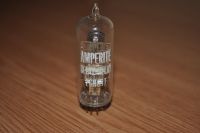

radhoo, Sat Mar 19 2011, 10:06AM
A nice relay tube, but filament broken :(


Re: What are the most interesting vacuum tubes in your collection?
Proud Mary, Sat Mar 19 2011, 10:20AM
It's an HT delay relay - used to delay the application of high voltage to thermionic valves until their heaters have reached full temperature.
Proud Mary, Sat Mar 19 2011, 10:20AM
It's an HT delay relay - used to delay the application of high voltage to thermionic valves until their heaters have reached full temperature.
Re: What are the most interesting vacuum tubes in your collection?
radhoo, Wed Mar 23 2011, 09:50AM
The hottest tube I got so far: JAN-1B22 - A Radium-226 Spark Gap:
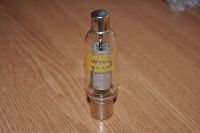

The maximum reading was 9uSv/h . According to this source it contains up to 2.95uC of Ra226.
The 1B22 is an aluminium cathode spark gap tube for radar modulator use. It was developed for the ASH (later AN/APS-4) radar, where two tubes in series switched a peak power of around 105kW into a 725A magnetron. In order to maintain operation at high altitudes even if the pressurised container failed, the peak switching voltage was kept to 4kV. The tubes could pass a current pulse of 67A for 0.75µs at either 600 or 1000 pulses per second. They could also operate for short periods at 2.25µs/330pps.
Anode/cathode spacing is 150 mils, and the gas mixture at 20" pressure is 75% hydrogen and 25% argon. Life expectancy was 500 hours at 0.75µs.
Corona points at the end of the cathode opposite the end of the anode assist firing, the firing voltage being 2.7kV. The tube also contains a small quantity of radium in this region.
By design the tube must be operated with the cathode opening downward; the aluminum eroded by sparks is mostly transferred to anode, leaving approximately constant the electrode spacing through the useful life.
radhoo, Wed Mar 23 2011, 09:50AM
The hottest tube I got so far: JAN-1B22 - A Radium-226 Spark Gap:


The maximum reading was 9uSv/h . According to this source it contains up to 2.95uC of Ra226.
The 1B22 is an aluminium cathode spark gap tube for radar modulator use. It was developed for the ASH (later AN/APS-4) radar, where two tubes in series switched a peak power of around 105kW into a 725A magnetron. In order to maintain operation at high altitudes even if the pressurised container failed, the peak switching voltage was kept to 4kV. The tubes could pass a current pulse of 67A for 0.75µs at either 600 or 1000 pulses per second. They could also operate for short periods at 2.25µs/330pps.
Anode/cathode spacing is 150 mils, and the gas mixture at 20" pressure is 75% hydrogen and 25% argon. Life expectancy was 500 hours at 0.75µs.
Corona points at the end of the cathode opposite the end of the anode assist firing, the firing voltage being 2.7kV. The tube also contains a small quantity of radium in this region.
By design the tube must be operated with the cathode opening downward; the aluminum eroded by sparks is mostly transferred to anode, leaving approximately constant the electrode spacing through the useful life.
Re: What are the most interesting vacuum tubes in your collection?
Proud Mary, Wed Mar 23 2011, 10:08AM
That's 109150 disintegrations per second - a good illustration of the very low gamma detection efficiency of GM tubes, when you think of the small number actually counted.
Proud Mary, Wed Mar 23 2011, 10:08AM
radhoo wrote ...
it contains up to 2.95uC of Ra226.
it contains up to 2.95uC of Ra226.
That's 109150 disintegrations per second - a good illustration of the very low gamma detection efficiency of GM tubes, when you think of the small number actually counted.
Re: What are the most interesting vacuum tubes in your collection?
radhoo, Wed Mar 23 2011, 12:03PM
BTW, I got my scintillation probes up and running. Funny - they are not responding to my gamma sources, but quite the opposite when put close to an X-ray emitting tube.
radhoo, Wed Mar 23 2011, 12:03PM
Proud Mary wrote ...
That's 109150 disintegrations per second - a good illustration of the very low gamma detection efficiency of GM tubes, when you think of the small number actually counted.
Indeed. That's 109150 disintegrations per second - a good illustration of the very low gamma detection efficiency of GM tubes, when you think of the small number actually counted.
BTW, I got my scintillation probes up and running. Funny - they are not responding to my gamma sources, but quite the opposite when put close to an X-ray emitting tube.
Re: What are the most interesting vacuum tubes in your collection?
radhoo, Wed Mar 23 2011, 12:33PM
4 nice Klystron tubes:
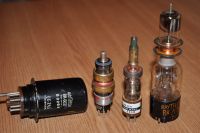
Raytheon RK-6037
Raytheon JAN-5837
Beam Tube Corp. 6236
Raytheon RK-707
radhoo, Wed Mar 23 2011, 12:33PM
4 nice Klystron tubes:

Raytheon RK-6037
Raytheon JAN-5837
Beam Tube Corp. 6236
Raytheon RK-707
Re: What are the most interesting vacuum tubes in your collection?
Proud Mary, Wed Mar 23 2011, 12:49PM
Well, that is good news!
This is what we'd expect to see with a thin scintillator. Low energy X-ray/gamma photons and high energy beta particles will be stopped by it, and cause a flash of light, while higher energy photons pass straight through it without interaction. The thin scintillator allows more of the light pulses to escape and be detected by the photomultiplier, and so has a higher detection efficiency.
Proud Mary, Wed Mar 23 2011, 12:49PM
radhoo wrote ...
BTW, I got my scintillation probes up and running. Funny - they are not responding to my gamma sources, but quite the opposite when put close to an X-ray emitting tube.
BTW, I got my scintillation probes up and running. Funny - they are not responding to my gamma sources, but quite the opposite when put close to an X-ray emitting tube.
Well, that is good news!

This is what we'd expect to see with a thin scintillator. Low energy X-ray/gamma photons and high energy beta particles will be stopped by it, and cause a flash of light, while higher energy photons pass straight through it without interaction. The thin scintillator allows more of the light pulses to escape and be detected by the photomultiplier, and so has a higher detection efficiency.
Re: What are the most interesting vacuum tubes in your collection?
Proud Mary, Wed Mar 23 2011, 02:14PM
Here's a miniature reflex klystron with rectangular waveguide flange underneath.
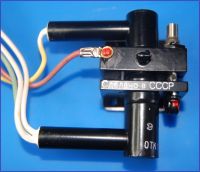
The cavity tuning screw is at upper right.
Proud Mary, Wed Mar 23 2011, 02:14PM
radhoo wrote ...
4 nice Klystron tubes:

Raytheon RK-6037
Raytheon JAN-5837
Beam Tube Corp. 6236
Raytheon RK-707
4 nice Klystron tubes:

Raytheon RK-6037
Raytheon JAN-5837
Beam Tube Corp. 6236
Raytheon RK-707
Here's a miniature reflex klystron with rectangular waveguide flange underneath.

The cavity tuning screw is at upper right.
Re: What are the most interesting vacuum tubes in your collection?
radhoo, Mon Mar 28 2011, 08:47PM
That's a nice one , Stella, I was wondering how to power these little things ( I do have detector UHF diodes as well).
Here'a GU81m and the GMI90:
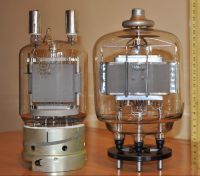
radhoo, Mon Mar 28 2011, 08:47PM
That's a nice one , Stella, I was wondering how to power these little things ( I do have detector UHF diodes as well).
Here'a GU81m and the GMI90:

Re: What are the most interesting vacuum tubes in your collection?
Proud Mary, Mon Mar 28 2011, 10:25PM
I got these details from Gintaras. I bought two from the same series, but with different frequencies. I haven't tried them out yet!
Heater 6.3V @ 0.5-1.3A
Resonator Voltage 350V
Negative repeller Voltage -50V to -350V
The resistance value in the repeller circuit no more than 100KOhm
Load SWR 1.2 max.
Cathode current 10mA to 50mA
Frequency stabilization time 5min max
Leads:
Yellow - Repeller
Green - Filament
White - Cathode
White - Cathode & Filament
Red - Resonator
Cooling: forced air. Air flow velocity should be 3meters/second.
When switching on apply voltages in following order:
1. Apply forced air.
2. Apply filament voltage, let the klistron heat up for 1 minute.
3. Apply negative repeller voltage.
4. Apply the resonator voltage.
Repeat steps 1-4 backwards when switching the klystron off.
Frequency goes up when turning the tuning screw counterclockwise.
Proud Mary, Mon Mar 28 2011, 10:25PM
radhoo wrote ...
That's a nice one , Stella, I was wondering how to power these little things ( I do have detector UHF diodes as well).
That's a nice one , Stella, I was wondering how to power these little things ( I do have detector UHF diodes as well).
I got these details from Gintaras. I bought two from the same series, but with different frequencies. I haven't tried them out yet!

Heater 6.3V @ 0.5-1.3A
Resonator Voltage 350V
Negative repeller Voltage -50V to -350V
The resistance value in the repeller circuit no more than 100KOhm
Load SWR 1.2 max.
Cathode current 10mA to 50mA
Frequency stabilization time 5min max
Leads:
Yellow - Repeller
Green - Filament
White - Cathode
White - Cathode & Filament
Red - Resonator
Cooling: forced air. Air flow velocity should be 3meters/second.
When switching on apply voltages in following order:
1. Apply forced air.
2. Apply filament voltage, let the klistron heat up for 1 minute.
3. Apply negative repeller voltage.
4. Apply the resonator voltage.
Repeat steps 1-4 backwards when switching the klystron off.
Frequency goes up when turning the tuning screw counterclockwise.
Re: What are the most interesting vacuum tubes in your collection?
radhoo, Mon Mar 28 2011, 10:29PM
It seems you've got the basic datasheet parameters, would be great if we could find an application or some functionality details.
radhoo, Mon Mar 28 2011, 10:29PM
It seems you've got the basic datasheet parameters, would be great if we could find an application or some functionality details.
Re: What are the most interesting vacuum tubes in your collection?
Proud Mary, Mon Mar 28 2011, 10:35PM
Yes, it does seem a pity to have them and not use them for anything. I will think about it.
Afterthought: I've just measured the internal dimensions of the exit waveguide coupler, which shows that the device is intended to operate somewhere between 7.05GHz and 10GHz.
My frequency counter only goes up to 2.4GHz, but we can always fall back on Lecher wires to get a rough idea of the frequency - and of course very very much shorter than the parallel tuned line shown in this splendid engraving:
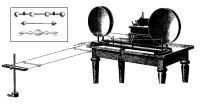
Proud Mary, Mon Mar 28 2011, 10:35PM
radhoo wrote ...
It seems you've got the basic datasheet parameters, would be great if we could find an application or some functionality details.
It seems you've got the basic datasheet parameters, would be great if we could find an application or some functionality details.
Yes, it does seem a pity to have them and not use them for anything. I will think about it.
Afterthought: I've just measured the internal dimensions of the exit waveguide coupler, which shows that the device is intended to operate somewhere between 7.05GHz and 10GHz.
My frequency counter only goes up to 2.4GHz, but we can always fall back on Lecher wires to get a rough idea of the frequency - and of course very very much shorter than the parallel tuned line shown in this splendid engraving:

Re: What are the most interesting vacuum tubes in your collection?
Dave47, Tue Mar 29 2011, 04:00PM
Electron Spin Resonance?

The nice thing about a klystron is that you can tune them electrically in addition to the manual tuning screw.
I used a spectrometer based on a magic tee in grad school. I was tasked with rebuilding the automatic frequency controller with solid state components in place of the 30 year old tube based AFC.
David
Dave47, Tue Mar 29 2011, 04:00PM
Proud Mary wrote ...
Yes, it does seem a pity to have them and not use them for anything. I will think about it.
radhoo wrote ...
It seems you've got the basic datasheet parameters, would be great if we could find an application or some functionality details.
It seems you've got the basic datasheet parameters, would be great if we could find an application or some functionality details.
Yes, it does seem a pity to have them and not use them for anything. I will think about it.
Electron Spin Resonance?

The nice thing about a klystron is that you can tune them electrically in addition to the manual tuning screw.
I used a spectrometer based on a magic tee in grad school. I was tasked with rebuilding the automatic frequency controller with solid state components in place of the 30 year old tube based AFC.
David
Re: What are the most interesting vacuum tubes in your collection?
Proud Mary, Tue Mar 29 2011, 04:47PM
Hi David,
I'd guess that my miniature klystrons were designed for use as local oscillators, and might have an output of 5 or 10mW on a good day.
Would that be enough for ESR?
Stella
Proud Mary, Tue Mar 29 2011, 04:47PM
Dave47 wrote ...
Electron Spin Resonance?
Electron Spin Resonance?
Hi David,
I'd guess that my miniature klystrons were designed for use as local oscillators, and might have an output of 5 or 10mW on a good day.
Would that be enough for ESR?
Stella
Re: What are the most interesting vacuum tubes in your collection?
radhoo, Tue Mar 29 2011, 05:07PM
The datasheet for the 6236, shows 125mW output, and a frequency range of 3.8 to 7.6 GHz. There's also a circuit diagram here:
For an even lower frequency range, the 5837 operates between 550 to 3800MHz . Some details and schematic here (probably the simplest circuit): . I have also attached the datasheet for this one. The 5837 tube I have is still in a good shape, with intact filament.
. I have also attached the datasheet for this one. The 5837 tube I have is still in a good shape, with intact filament.
The RK707 seems to be an old model, a few basic details here: . I do not have the datasheet for it.
. I do not have the datasheet for it.
Same for the RK-6037 no datasheet.
What frequency counter are you using, Stella?
]5837.pdf[/file]
radhoo, Tue Mar 29 2011, 05:07PM
The datasheet for the 6236, shows 125mW output, and a frequency range of 3.8 to 7.6 GHz. There's also a circuit diagram here:

For an even lower frequency range, the 5837 operates between 550 to 3800MHz . Some details and schematic here (probably the simplest circuit):
 . I have also attached the datasheet for this one. The 5837 tube I have is still in a good shape, with intact filament.
. I have also attached the datasheet for this one. The 5837 tube I have is still in a good shape, with intact filament.The RK707 seems to be an old model, a few basic details here:
 . I do not have the datasheet for it.
. I do not have the datasheet for it.Same for the RK-6037 no datasheet.
What frequency counter are you using, Stella?
]5837.pdf[/file]
Re: What are the most interesting vacuum tubes in your collection?
Proud Mary, Tue Mar 29 2011, 05:20PM
It's a Black Star Nova 2400 counter timer. Black Star Instruments was taken over by Thurlby Thandar a few years ago, so the Black Star brand has ceased to exist.
There's a spec sheet for the Nova 2400 here:

Proud Mary, Tue Mar 29 2011, 05:20PM
radhoo wrote ...
What frequency counter are you using, Stella?
What frequency counter are you using, Stella?
It's a Black Star Nova 2400 counter timer. Black Star Instruments was taken over by Thurlby Thandar a few years ago, so the Black Star brand has ceased to exist.
There's a spec sheet for the Nova 2400 here:

Re: What are the most interesting vacuum tubes in your collection?
Dave47, Wed Mar 30 2011, 02:34AM
I used a Varian 2k25 which was rated at about 25mW from 8.5GHz to 10.2 GHz and was coupled to TE10 waveguide. 10mW is still probably enough since you can build the spectrometer to be like a microwave Wheatstone bridge (using a magic tee).
I have some really bad pictures in my thesis from 1995 (drawn in Word) diagramming the setup. But, maybe if we want to discuss ESR (what I remember of it, anyway) we need a new topic?
David
Dave47, Wed Mar 30 2011, 02:34AM
Proud Mary wrote ...
Hi David,
I'd guess that my miniature klystrons were designed for use as local oscillators, and might have an output of 5 or 10mW on a good day.
Would that be enough for ESR?
Stella
Dave47 wrote ...
Electron Spin Resonance?
Electron Spin Resonance?
Hi David,
I'd guess that my miniature klystrons were designed for use as local oscillators, and might have an output of 5 or 10mW on a good day.
Would that be enough for ESR?
Stella
I used a Varian 2k25 which was rated at about 25mW from 8.5GHz to 10.2 GHz and was coupled to TE10 waveguide. 10mW is still probably enough since you can build the spectrometer to be like a microwave Wheatstone bridge (using a magic tee).
I have some really bad pictures in my thesis from 1995 (drawn in Word) diagramming the setup. But, maybe if we want to discuss ESR (what I remember of it, anyway) we need a new topic?
David
Re: What are the most interesting vacuum tubes in your collection?
radiotech, Thu Apr 21 2011, 01:08AM
Research Enterprises Limited REL 39B
CV 100
10E / CV100
The mesh is varnished on. Might be tropicalized WW2 radar rectifier. Two of the 3 clips on the base lead up to the stempress, one is sleeved in a glass tube leading ? Wire guage is small ~~ 22?
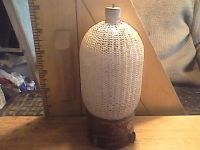
radiotech, Thu Apr 21 2011, 01:08AM
Research Enterprises Limited REL 39B
CV 100
10E / CV100
The mesh is varnished on. Might be tropicalized WW2 radar rectifier. Two of the 3 clips on the base lead up to the stempress, one is sleeved in a glass tube leading ? Wire guage is small ~~ 22?

Re: What are the most interesting vacuum tubes in your collection?
magnet18, Thu Apr 21 2011, 01:17AM
Wow, My most impressive tube is the IN-14 nixie

Other than that I just have some simple radio tubes I bought s replacements but apparently didn't need.
Hoping to nab some dekatrons sometime soon though...
[EDIT]
Don't worry, I fixed the over-current problem from the video.
magnet18, Thu Apr 21 2011, 01:17AM
Wow, My most impressive tube is the IN-14 nixie

Other than that I just have some simple radio tubes I bought s replacements but apparently didn't need.
Hoping to nab some dekatrons sometime soon though...
[EDIT]
Don't worry, I fixed the over-current problem from the video.
Re: What are the most interesting vacuum tubes in your collection?
radhoo, Sat Aug 06 2011, 09:33AM
TGI2-400/16 Hydrogen Thyratron , Supporting up to 400A 16KV pulses,

Datasheet attached. I will use it for a relaxation oscillator.
]thyratron_tgi2.pdf[/file]
The picture shows it close to a DY86 vacuum rectifier for size comparison.
radhoo, Sat Aug 06 2011, 09:33AM
TGI2-400/16 Hydrogen Thyratron , Supporting up to 400A 16KV pulses,

Datasheet attached. I will use it for a relaxation oscillator.
]thyratron_tgi2.pdf[/file]
The picture shows it close to a DY86 vacuum rectifier for size comparison.
Re: What are the most interesting vacuum tubes in your collection?
radhoo, Sat Aug 06 2011, 09:35AM
5980 BS-2 a GM detector tube for Gamma radiation:

I have two pieces, so I can trade one for a different tube.
radhoo, Sat Aug 06 2011, 09:35AM
5980 BS-2 a GM detector tube for Gamma radiation:

I have two pieces, so I can trade one for a different tube.
Re: What are the most interesting vacuum tubes in your collection?
radhoo, Sat Aug 06 2011, 09:38AM
6390, a Klystron reflex tube, yet another candidate for my UHF experimental setup.


It features some interesting characteristics:
Output frequency: 6700 MHz -> 11050 MHz
Output power: 60 mW max.
radhoo, Sat Aug 06 2011, 09:38AM
6390, a Klystron reflex tube, yet another candidate for my UHF experimental setup.


It features some interesting characteristics:
Output frequency: 6700 MHz -> 11050 MHz
Output power: 60 mW max.
Re: What are the most interesting vacuum tubes in your collection?
radhoo, Sat Aug 06 2011, 09:42AM
PEK-110, mercury vapour arc lamp, a lab precision UV light source,


It works at 18V, 5.5Amps, and it requires a short HV pulse (aprox 1500V DC) to ionize the gas and start the low voltage discharge.
radhoo, Sat Aug 06 2011, 09:42AM
PEK-110, mercury vapour arc lamp, a lab precision UV light source,


It works at 18V, 5.5Amps, and it requires a short HV pulse (aprox 1500V DC) to ionize the gas and start the low voltage discharge.
Re: What are the most interesting vacuum tubes in your collection?
Proud Mary, Sat Aug 06 2011, 10:38AM
Recommended anode resistor: 1MΩ
Maximum starting voltage: 640V
Recommended operating voltage: 700V
Operating voltage range: 660 - 800V
Maximum plateau slope: 20%/100V
Minimum dead time: 45 μs
Gamma sensitivity Co60 (cps/mr/hr): 3.5
Tube capacitance: 3pF
Weight: 10 g
Maximum background shielded inside 50mm Pb + 3mm Al: 10 cpm
Proud Mary, Sat Aug 06 2011, 10:38AM
radhoo wrote ...
5980 BS-2 a GM detector tube for Gamma radiation:

I have two pieces, so I can trade one for a different tube.
5980 BS-2 a GM detector tube for Gamma radiation:

I have two pieces, so I can trade one for a different tube.
Recommended anode resistor: 1MΩ
Maximum starting voltage: 640V
Recommended operating voltage: 700V
Operating voltage range: 660 - 800V
Maximum plateau slope: 20%/100V
Minimum dead time: 45 μs
Gamma sensitivity Co60 (cps/mr/hr): 3.5
Tube capacitance: 3pF
Weight: 10 g
Maximum background shielded inside 50mm Pb + 3mm Al: 10 cpm
Re: What are the most interesting vacuum tubes in your collection?
radhoo, Sat Aug 06 2011, 11:23AM
A ballast tube, K80-B, from 1935:

Thanks for those details, Stella!
radhoo, Sat Aug 06 2011, 11:23AM
A ballast tube, K80-B, from 1935:

Thanks for those details, Stella!
Re: What are the most interesting vacuum tubes in your collection?
radhoo, Sat Aug 06 2011, 11:27AM
A neon filled tube, Philips 4378. Breakpoint between 80 and 120V .


radhoo, Sat Aug 06 2011, 11:27AM
A neon filled tube, Philips 4378. Breakpoint between 80 and 120V .


Re: What are the most interesting vacuum tubes in your collection?
radhoo, Sat Aug 06 2011, 11:35AM
Here is a cold cathode triode, JAN-CW-313CD painted in black to reduce ambient light photoelectric effects,
This tube originally contained a small quantity of Kr-85, a beta emitter. The half life for this isotope is of aprox. 10years. The tube doesn't present detectable radiation emissions, not a big surprise since it is from 1950 and the Kr-85 inside is long gone.



Designed for 200V, 25mA.

This last pic shows the tube being lit by the strong RF field of my GI30 VTTC.
radhoo, Sat Aug 06 2011, 11:35AM
Here is a cold cathode triode, JAN-CW-313CD painted in black to reduce ambient light photoelectric effects,
This tube originally contained a small quantity of Kr-85, a beta emitter. The half life for this isotope is of aprox. 10years. The tube doesn't present detectable radiation emissions, not a big surprise since it is from 1950 and the Kr-85 inside is long gone.



Designed for 200V, 25mA.

This last pic shows the tube being lit by the strong RF field of my GI30 VTTC.
Re: What are the most interesting vacuum tubes in your collection?
radhoo, Sat Aug 06 2011, 11:39AM
GI-30, a Russian double tetrode:

And a VTTC tesla coil that uses this tube:

Schematics also available here:
radhoo, Sat Aug 06 2011, 11:39AM
GI-30, a Russian double tetrode:

And a VTTC tesla coil that uses this tube:

Schematics also available here:

Re: What are the most interesting vacuum tubes in your collection?
Proud Mary, Sat Aug 06 2011, 06:51PM
A trace of the 85Kr must remain, but with an average β energy of just 251 keV for the main (99.57%) disintegration mode, almost nothing will escape the glass envelope - which is why this isotope was selected in the first place. A β scintillator of suitable energy response and PHA could still detect the residue if the glass was removed.
85Kr is perhaps one of the most searched after isotopes in the world - searched after because tiny trace levels of 85Kr in air or water may point to undeclared or clandestine Pu production nearby.
Proud Mary, Sat Aug 06 2011, 06:51PM
radhoo wrote ...
Here is a cold cathode triode, JAN-CW-313CD painted in black to reduce ambient light photoelectric effects,
This tube originally contained a small quantity of Kr-85, a beta emitter. The half life for this isotope is of aprox. 10years. The tube doesn't present detectable radiation emissions, not a big surprise since it is from 1950 and the Kr-85 inside is long gone.
Here is a cold cathode triode, JAN-CW-313CD painted in black to reduce ambient light photoelectric effects,
This tube originally contained a small quantity of Kr-85, a beta emitter. The half life for this isotope is of aprox. 10years. The tube doesn't present detectable radiation emissions, not a big surprise since it is from 1950 and the Kr-85 inside is long gone.
A trace of the 85Kr must remain, but with an average β energy of just 251 keV for the main (99.57%) disintegration mode, almost nothing will escape the glass envelope - which is why this isotope was selected in the first place. A β scintillator of suitable energy response and PHA could still detect the residue if the glass was removed.
85Kr is perhaps one of the most searched after isotopes in the world - searched after because tiny trace levels of 85Kr in air or water may point to undeclared or clandestine Pu production nearby.
Re: What are the most interesting vacuum tubes in your collection?
Proud Mary, Sun Aug 07 2011, 02:41PM
RCA 955 "Acorn" UHF Triode
'DETECTOR, AMPLIFIER, OSCILLATOR'
"Especially for wavelengths between 0.5 meters and 5 meters"

955 was one of the first valves to be designed specifically for UHF applications in 1934. The revolutionary 'acorn' design allows the shortest possible paths to cathode, grid, and anode. Careful construction will allow oscillation up to about 1000 MHz. They are great fun for a one valve VHF/UHF super-regenerative receiver, as well as for many more serious uses.
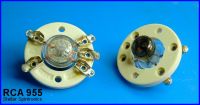
It is possible to solder directly to the pin-outs - on a cut-out in a PCB, for example - but there is always a risk of cracking the glass seals. I was lucky to find a stash of these purpose built ceramic 'acorn' valve mountings in nasty used condition, but most of them have come out very nicely after a good wash and brush up in the kitchen sink.
Full 955 data sheet with nifty application circuits is here:
Proud Mary, Sun Aug 07 2011, 02:41PM
RCA 955 "Acorn" UHF Triode
'DETECTOR, AMPLIFIER, OSCILLATOR'
"Especially for wavelengths between 0.5 meters and 5 meters"

955 was one of the first valves to be designed specifically for UHF applications in 1934. The revolutionary 'acorn' design allows the shortest possible paths to cathode, grid, and anode. Careful construction will allow oscillation up to about 1000 MHz. They are great fun for a one valve VHF/UHF super-regenerative receiver, as well as for many more serious uses.

It is possible to solder directly to the pin-outs - on a cut-out in a PCB, for example - but there is always a risk of cracking the glass seals. I was lucky to find a stash of these purpose built ceramic 'acorn' valve mountings in nasty used condition, but most of them have come out very nicely after a good wash and brush up in the kitchen sink.
Full 955 data sheet with nifty application circuits is here:

Re: What are the most interesting vacuum tubes in your collection?
radhoo, Mon Aug 08 2011, 03:44PM
And here are some UHF relatives:

From the left to the right:
6264A : datasheet:
2B22 : working as a detector up to 1,5GHz! Details here:
446A: more details here:
710A: details:
radhoo, Mon Aug 08 2011, 03:44PM
And here are some UHF relatives:

From the left to the right:
6264A : datasheet:

2B22 : working as a detector up to 1,5GHz! Details here:

446A: more details here:

710A: details:

Re: What are the most interesting vacuum tubes in your collection?
radhoo, Thu Aug 11 2011, 02:35PM
G21H, a halogen quenched Geiger Muller tube for Gamma radiation, Made in Romania, at the Institute of Atomic Physics .
More details in the tube's passport, pictured below:

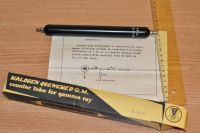

radhoo, Thu Aug 11 2011, 02:35PM
G21H, a halogen quenched Geiger Muller tube for Gamma radiation, Made in Romania, at the Institute of Atomic Physics .
More details in the tube's passport, pictured below:



Re: What are the most interesting vacuum tubes in your collection?
radhoo, Thu Aug 11 2011, 02:43PM
A fine photomultiplier tube, M12FS60, with a 5cm diameter window.
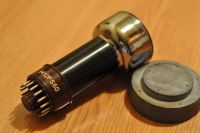
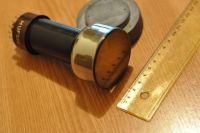
radhoo, Thu Aug 11 2011, 02:43PM
A fine photomultiplier tube, M12FS60, with a 5cm diameter window.


Re: What are the most interesting vacuum tubes in your collection?
radhoo, Thu Aug 11 2011, 03:00PM
ok, don't hate me for having this tube :)
It's a monster photomultiplier tube, with an excellent sensitivity, making it the best candidate for a highly sensitive scintillator.
M12FS100, here are some pics, and a comparison to the russian Gu81m . Window diameter 10cm!
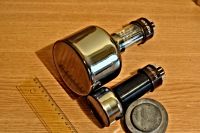
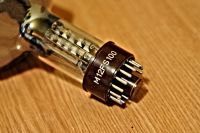
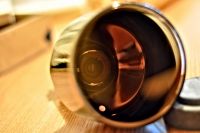
M12FS100 and Gu81m:
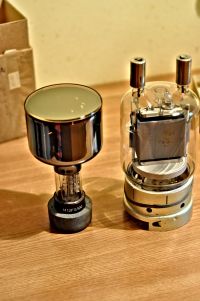
Here are the tube's parameters (in German)
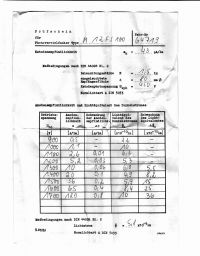
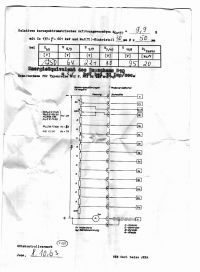
radhoo, Thu Aug 11 2011, 03:00PM
ok, don't hate me for having this tube :)
It's a monster photomultiplier tube, with an excellent sensitivity, making it the best candidate for a highly sensitive scintillator.
M12FS100, here are some pics, and a comparison to the russian Gu81m . Window diameter 10cm!



M12FS100 and Gu81m:

Here are the tube's parameters (in German)


Re: What are the most interesting vacuum tubes in your collection?
Proud Mary, Fri Aug 12 2011, 02:48PM
Svetlana 0.0045BSM-1-Ni

Svetlana type designation system: (Power in kW - 0.0045)(Svetlana class - BSM-1)(Anode composition - Ni)
Directly-heated electron-impact diode, without focusing cup or grid. There are two Be windows at 180° on either side of the tube body for multi-task bench use.
Va = 10 - 30 kV.
Vf = 0.75 - 2V
If = 1 - 3A
Ia must be adjusted by altering If so that Pin does not exceed 4.5W at the chosen anode voltage.

K𛼠for nickel is 7.47 keV.
Anode over-voltage of 15 - 22keV (i.e. two to three times Kð›¼) is required for full K𛼠excitation.
Efficiency: Using Sprawls' efficiency approximation ( kV*Z*10E-06 ) nickel-anode photon production efficiency is 2.8*10E-03 at 10kV, rising to 8.4*10E-03 at the tube's 30kV maximum.
Proud Mary, Fri Aug 12 2011, 02:48PM
Svetlana 0.0045BSM-1-Ni

Svetlana type designation system: (Power in kW - 0.0045)(Svetlana class - BSM-1)(Anode composition - Ni)
Directly-heated electron-impact diode, without focusing cup or grid. There are two Be windows at 180° on either side of the tube body for multi-task bench use.
Va = 10 - 30 kV.
Vf = 0.75 - 2V
If = 1 - 3A
Ia must be adjusted by altering If so that Pin does not exceed 4.5W at the chosen anode voltage.

K𛼠for nickel is 7.47 keV.
Anode over-voltage of 15 - 22keV (i.e. two to three times Kð›¼) is required for full K𛼠excitation.
Efficiency: Using Sprawls' efficiency approximation ( kV*Z*10E-06 ) nickel-anode photon production efficiency is 2.8*10E-03 at 10kV, rising to 8.4*10E-03 at the tube's 30kV maximum.
Re: What are the most interesting vacuum tubes in your collection?
radhoo, Fri Aug 12 2011, 09:45PM
radhoo, Fri Aug 12 2011, 09:45PM
Proud Mary wrote ...
Svetlana 0.0045BSM-1-Ni
Looks like you brought in some heavy artillery. SweetSvetlana 0.0045BSM-1-Ni
Re: What are the most interesting vacuum tubes in your collection?
Proud Mary, Sat Aug 13 2011, 12:23AM
Svetlana 0.025BSV-7-Fe
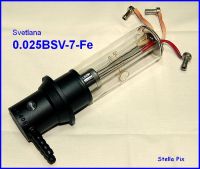
Liquid-cooled 25W grid-controlled electron-impact micro-focus triode photon source with Fe anode and two opposing Be windows.
Va = 45 kV max
Ia = 550 μA max
Vf = 4 V max
If = 2.5 ±0.1 A max
Pin = 25W max
This triode device is designed to operate in constant voltage anode mode, with the anode current determined by the level of grid bias. Pulse modulation of the grid will produce corresponding pulses in photon output.

Characteristic energy spectrum of Fe anode.
Fe Kα is at 6.4 keV
Proud Mary, Sat Aug 13 2011, 12:23AM
Svetlana 0.025BSV-7-Fe

Liquid-cooled 25W grid-controlled electron-impact micro-focus triode photon source with Fe anode and two opposing Be windows.
Va = 45 kV max
Ia = 550 μA max
Vf = 4 V max
If = 2.5 ±0.1 A max
Pin = 25W max
This triode device is designed to operate in constant voltage anode mode, with the anode current determined by the level of grid bias. Pulse modulation of the grid will produce corresponding pulses in photon output.

Characteristic energy spectrum of Fe anode.
Fe Kα is at 6.4 keV
Re: What are the most interesting vacuum tubes in your collection?
radhoo, Sat Aug 13 2011, 07:04AM
UV3 (Russian ув-3), a Traveling wave tube:
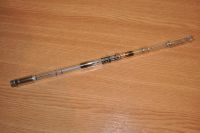
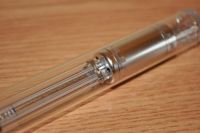

Some details on the functionality here:
radhoo, Sat Aug 13 2011, 07:04AM
UV3 (Russian ув-3), a Traveling wave tube:



Some details on the functionality here:

Re: What are the most interesting vacuum tubes in your collection?
Proud Mary, Sat Aug 13 2011, 10:17AM
Svetlana 0.3BSV-25-Ag

0.3BSV-25-Ag is a 300W silver anode electron-impact photon source of 'massive anode' design, which must be bolted to a water-cooled copper block.
Four Be windows in two opposing pairs offer both a 0.07*2.0mm line (at 90° to the horizontal axis of the filament) and a spot parallel to the filament's axis.
Electrical connection to the filament is made by a high-temperature ceramic plug which mates with the socket at the bottom of the glass barrel.
Va - 60kV max
Vf - 3V
If - 3A
Pin - 300W max

Kα for Ag is 22.15 keV corresponding to a wavelength of 5.59E-9 cm, where:
E = energy in ergs (1eV = 1.6 x 10E-12erg)
h = Planck's Constant = 6.614 x 10E-27erg-sec
c = velocity of light = 3 x 10E10cm/sec
w = wavelength in cm (1Ã… = 1 x 10-8cm)
Then:
E =hc/w
22.15 E3*1.6 E-12 = (6.614E-27*3E10)/w
W = 5.59E-9 cm or 0.559 Ã…
According to Svetlana, 4 keV is the lowest photon energy which can be transmitted through the Be windows in this design.
Proud Mary, Sat Aug 13 2011, 10:17AM
Svetlana 0.3BSV-25-Ag

0.3BSV-25-Ag is a 300W silver anode electron-impact photon source of 'massive anode' design, which must be bolted to a water-cooled copper block.
Four Be windows in two opposing pairs offer both a 0.07*2.0mm line (at 90° to the horizontal axis of the filament) and a spot parallel to the filament's axis.
Electrical connection to the filament is made by a high-temperature ceramic plug which mates with the socket at the bottom of the glass barrel.
Va - 60kV max
Vf - 3V
If - 3A
Pin - 300W max

Kα for Ag is 22.15 keV corresponding to a wavelength of 5.59E-9 cm, where:
E = energy in ergs (1eV = 1.6 x 10E-12erg)
h = Planck's Constant = 6.614 x 10E-27erg-sec
c = velocity of light = 3 x 10E10cm/sec
w = wavelength in cm (1Ã… = 1 x 10-8cm)
Then:
E =hc/w
22.15 E3*1.6 E-12 = (6.614E-27*3E10)/w
W = 5.59E-9 cm or 0.559 Ã…
According to Svetlana, 4 keV is the lowest photon energy which can be transmitted through the Be windows in this design.
Re: What are the most interesting vacuum tubes in your collection?
Daniel Kramnik, Sun Sept 04 2011, 03:08AM
My homebuilt cathode ray tubes!


Daniel Kramnik, Sun Sept 04 2011, 03:08AM
My homebuilt cathode ray tubes!


Re: What are the most interesting vacuum tubes in your collection?
radiotech, Sat Sept 24 2011, 03:15AM
Water cooled magnetron type VX 1.061 Waveguide and water inlet outlet shown too.

wVElink={e_FILE}public/ 1316833528_2463_FT109016_2011-09-24_18-46- 45.729.jpg][/link]

radiotech, Sat Sept 24 2011, 03:15AM
Water cooled magnetron type VX 1.061 Waveguide and water inlet outlet shown too.

wVElink={e_FILE}public/ 1316833528_2463_FT109016_2011-09-24_18-46- 45.729.jpg][/link]

Re: What are the most interesting vacuum tubes in your collection?
Dr. Dark Current, Tue Sept 27 2011, 10:40AM
Note: the small tube in all pictures is for size comparison.
GU-81M: Transmitting pentode, Pa 450W, Po 700W, cooling: natural convection, direct heating.
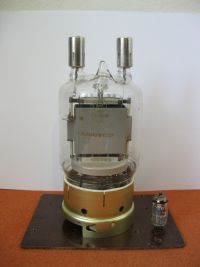
SRS 457: Transmitting tetrode, Pa 500W, Po 1.75kW, cooling: low velocity air flow, direct heating.
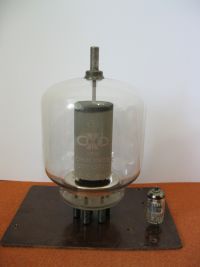
RD300S: Triode, industrial application. Pa 300W, cooling: low velocity air flow, direct heating.
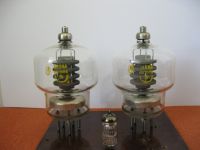
Q-1P/41: Transmitting tetrode, Pa 1kW, Po 1.6kW, cooling: forced air, indirect heating.
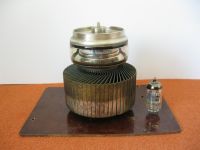
GMI-32b: Pulse tetrode, Pa 2kW, Vap 40kV, Iap 100A, cooling: forced air, indirect heating. With cooling "chimney".
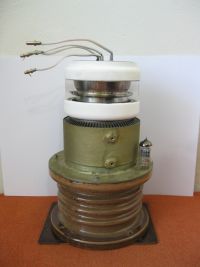
GU-39b: Transmitting tetrode, Pa 8kW, Po 13kW, cooling: forced air, direct heating.

GU-32: Double tetrode, transmission and oscillation.

DQ2: Mercury vapor rectifier.
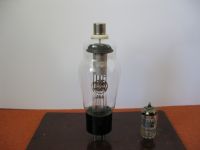
D2E: Deuterium spectral lamp.
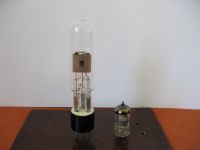
Zirconium hollow cathode lamp.

Photomultiplier tube.

4687: Voltage regulator.
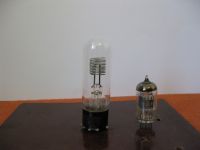
Dr. Dark Current, Tue Sept 27 2011, 10:40AM
Note: the small tube in all pictures is for size comparison.
GU-81M: Transmitting pentode, Pa 450W, Po 700W, cooling: natural convection, direct heating.

SRS 457: Transmitting tetrode, Pa 500W, Po 1.75kW, cooling: low velocity air flow, direct heating.

RD300S: Triode, industrial application. Pa 300W, cooling: low velocity air flow, direct heating.

Q-1P/41: Transmitting tetrode, Pa 1kW, Po 1.6kW, cooling: forced air, indirect heating.

GMI-32b: Pulse tetrode, Pa 2kW, Vap 40kV, Iap 100A, cooling: forced air, indirect heating. With cooling "chimney".

GU-39b: Transmitting tetrode, Pa 8kW, Po 13kW, cooling: forced air, direct heating.

GU-32: Double tetrode, transmission and oscillation.

DQ2: Mercury vapor rectifier.

D2E: Deuterium spectral lamp.

Zirconium hollow cathode lamp.

Photomultiplier tube.

4687: Voltage regulator.

Re: What are the most interesting vacuum tubes in your collection?
Conundrum, Wed Sept 28 2011, 05:17AM
I have some of those "top hat" microwave tubes thanks to Proud Mary
Also will post pics of my Russian VFDs and Gen 0 night vision tube and that flat CRT.
-A
Conundrum, Wed Sept 28 2011, 05:17AM
I have some of those "top hat" microwave tubes thanks to Proud Mary

Also will post pics of my Russian VFDs and Gen 0 night vision tube and that flat CRT.
-A
Re: What are the most interesting vacuum tubes in your collection?
radhoo, Wed Sept 28 2011, 12:38PM

radhoo, Wed Sept 28 2011, 12:38PM
Dr. Kilovolt wrote ...
Note: the small tube in all pictures is for size comparison.
Nice tubes Note: the small tube in all pictures is for size comparison.

Re: What are the most interesting vacuum tubes in your collection?
Proud Mary, Thu Sept 29 2011, 06:55PM
FX297 hydrogen thyratron
Triggered diode type
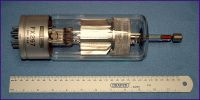
Va max = 25kV PIV
Ia pk = 500A
Ia av = 1.25A
Vtrig = 300 - 1000V
Rise time max = 2500A/μs
Vf = 6.3V
If = 21A
Proud Mary, Thu Sept 29 2011, 06:55PM
FX297 hydrogen thyratron
Triggered diode type

Va max = 25kV PIV
Ia pk = 500A
Ia av = 1.25A
Vtrig = 300 - 1000V
Rise time max = 2500A/μs
Vf = 6.3V
If = 21A
Re: What are the most interesting vacuum tubes in your collection?
IamSmooth, Fri Oct 07 2011, 03:22AM
Here is a power triode tube tester I built for the 211 845
I came up with the design for testing current conduction and transconductance during a swim.
tube tester
IamSmooth, Fri Oct 07 2011, 03:22AM
Here is a power triode tube tester I built for the 211 845
I came up with the design for testing current conduction and transconductance during a swim.
tube tester
Re: What are the most interesting vacuum tubes in your collection?
vasil, Fri Oct 07 2011, 01:44PM
That GU-39b tube looks very appealing to me....Worthing.
vasil, Fri Oct 07 2011, 01:44PM
That GU-39b tube looks very appealing to me....Worthing.
Re: What are the most interesting vacuum tubes in your collection?
radhoo, Thu Oct 13 2011, 09:37AM
TGI2 400/16 (ТГИ2-400/16) and TGI1 130/10 (ТГИ1-130/10) , two hydrogen thyratrons:
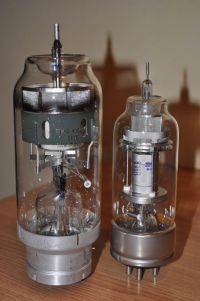
Some details on the first one here:
radhoo, Thu Oct 13 2011, 09:37AM
TGI2 400/16 (ТГИ2-400/16) and TGI1 130/10 (ТГИ1-130/10) , two hydrogen thyratrons:

Some details on the first one here:

Re: What are the most interesting vacuum tubes in your collection?
radhoo, Sun Nov 27 2011, 03:45PM
Russian sensitive gamma Geiger Muller tube, the SBM-19:
Datasheet/Details here:
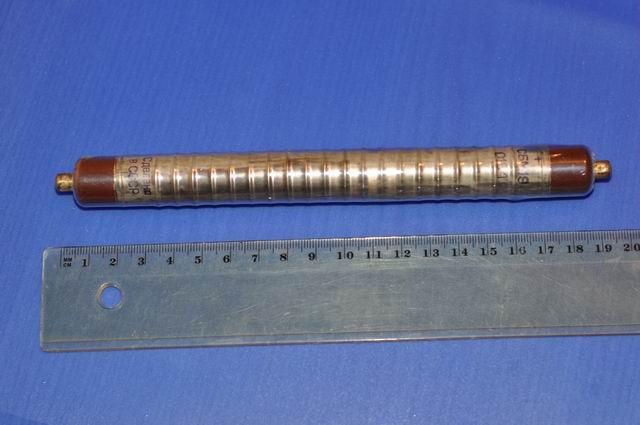
Russian MCT-17, Geiger Muller tube with an extra thin mica window, for Beta radiation detection:
Datasheet:
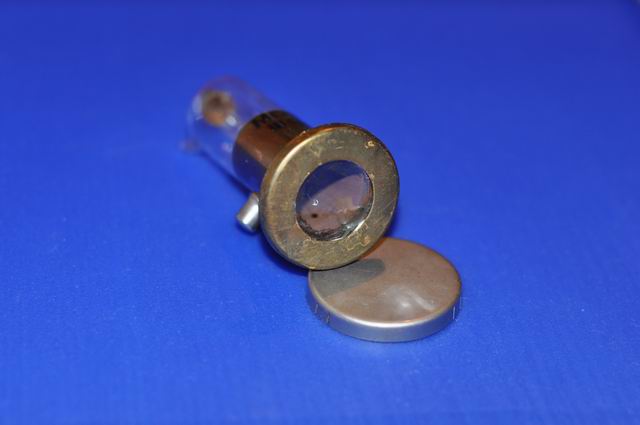
German VA-Z320, another Mica window Geiger Muller of superior quality, for Beta radiation:
Details:
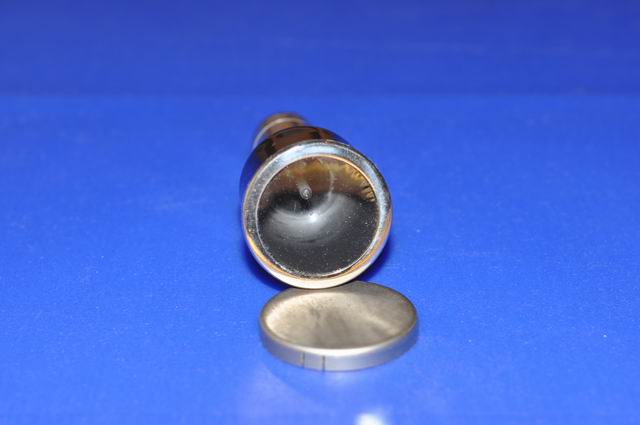
radhoo, Sun Nov 27 2011, 03:45PM
Russian sensitive gamma Geiger Muller tube, the SBM-19:
Datasheet/Details here:


Russian MCT-17, Geiger Muller tube with an extra thin mica window, for Beta radiation detection:
Datasheet:


German VA-Z320, another Mica window Geiger Muller of superior quality, for Beta radiation:
Details:


Re: What are the most interesting vacuum tubes in your collection?
radhoo, Wed Dec 21 2011, 10:33PM
MR-04, ionization tube,
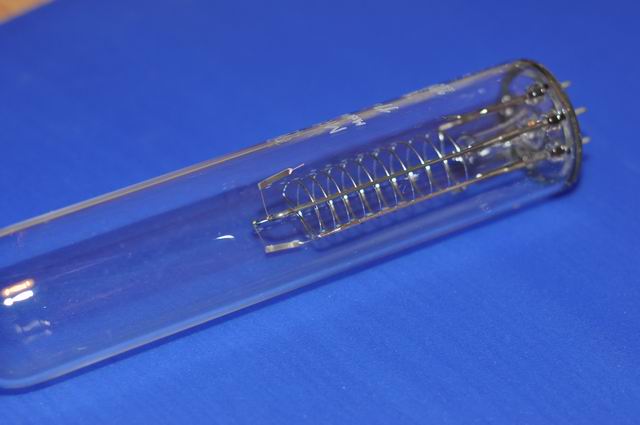
Details:

 (german)
(german)
radhoo, Wed Dec 21 2011, 10:33PM
MR-04, ionization tube,

Details:

 (german)
(german)Re: What are the most interesting vacuum tubes in your collection?
Marko, Wed Dec 21 2011, 11:52PM
Woah Jan, where do you get this kind of stuff? For some of my newest and most evil plans, I'd almost give a leg for one...
Marko
Marko, Wed Dec 21 2011, 11:52PM
GMI-32b: Pulse tetrode, Pa 2kW, Vap 40kV, Iap 100A, cooling: forced air, indirect heating. With cooling "chimney".
Woah Jan, where do you get this kind of stuff? For some of my newest and most evil plans, I'd almost give a leg for one...
Marko
Re: What are the most interesting vacuum tubes in your collection?
Dr. Dark Current, Tue Jan 10 2012, 11:25AM
SRS 326: Power triode, 250 watt plate dissipation.
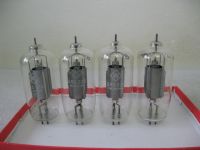
Dr. Dark Current, Tue Jan 10 2012, 11:25AM
SRS 326: Power triode, 250 watt plate dissipation.

Re: What are the most interesting vacuum tubes in your collection?
Proud Mary, Sun Jan 15 2012, 03:10PM
Centronic B12H glass beta-gamma GM detector
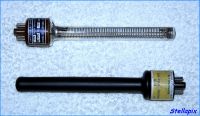
The tube with the clear glass was manufactured when Centronic was still called 20th Century Electronics. It can only be used in darkness, as UV photons will cause erratic firing, but it is ideal for measurement immersed in fluids.
The later version of B12H produced under the Centronic brand has an opaque coating, but even this thin layer causes some loss of beta sensitivity.
Both types have an International Octal 8-pin base.

I understand Centronic recently stopped supplying B12H, but its 50 year track record gives some idea of the the quality and usefulness of this outstanding detector.
EDIT: Whoops, I may have got that one wrong! B12H is still in the Centronic catalogue of standard detectors, though now with a nifty bright blue base, an old horse shod with new shoes. It is the similar, but higher voltage, B12N glass beta-gamma detector that has been phased out.
Proud Mary, Sun Jan 15 2012, 03:10PM
Centronic B12H glass beta-gamma GM detector

The tube with the clear glass was manufactured when Centronic was still called 20th Century Electronics. It can only be used in darkness, as UV photons will cause erratic firing, but it is ideal for measurement immersed in fluids.
The later version of B12H produced under the Centronic brand has an opaque coating, but even this thin layer causes some loss of beta sensitivity.
Both types have an International Octal 8-pin base.

I understand Centronic recently stopped supplying B12H, but its 50 year track record gives some idea of the the quality and usefulness of this outstanding detector.
EDIT: Whoops, I may have got that one wrong! B12H is still in the Centronic catalogue of standard detectors, though now with a nifty bright blue base, an old horse shod with new shoes. It is the similar, but higher voltage, B12N glass beta-gamma detector that has been phased out.
Re: What are the most interesting vacuum tubes in your collection?
Proud Mary, Tue Jan 17 2012, 02:01PM
Here is a B12N, which I refer to in the post above...
Centronic B12N beta-gamma GM detector

B12N is very slightly less sensitive than B12H, operates best at 675V, and its cathode is a conductive film deposited on the inside of the glass. The flash has made this fluoresce, so it is more apparent here than to the naked eye in natural daylight.
B12N uses Ne/halogen fill gas, and its LND near equivalent is 72514
Proud Mary, Tue Jan 17 2012, 02:01PM
Here is a B12N, which I refer to in the post above...
Centronic B12N beta-gamma GM detector

B12N is very slightly less sensitive than B12H, operates best at 675V, and its cathode is a conductive film deposited on the inside of the glass. The flash has made this fluoresce, so it is more apparent here than to the naked eye in natural daylight.
B12N uses Ne/halogen fill gas, and its LND near equivalent is 72514

Re: What are the most interesting vacuum tubes in your collection?
Proud Mary, Thu Jan 19 2012, 09:12PM
Centronics M2H (UK MOD CV2886) glass beta-gamma detector for sampling liquids
Another member of the Centronics glass beta-gamma detector family
This rubbery old horror was designed as an accessory for Meter, Contamination, No. 1 set, in 1953, so it's a bit of a surprise to find it still in the Centronics product guide.
M2H was intended for liquid sampling in Cold War doomsday applications. The end cap was removed while worried soldiers dribbled the suspect liquid into the space between the clear plastic container and the glass tube.

The base plugs into the ancient and absurdly expensive B2 (British 2-pin) socket, still widely used for GM tubes, whilst long obsolete everywhere else.

In the open end view below we can see the helical structure of the M2H cathode - as with B12H above - perhaps explaining the 'H' suffix. It looks as if it would be impossible to thoroughly decontaminate the sampling chamber after exposure to the highly radioactive liquids consequent upon a 1950s "A-bomb" blast, a shortcoming which also limits the use of M2H for accurate scientific work.
Of course, when using M2H as a general purpose gamma-only detector, there's no reason at all to remove the rubber cap.
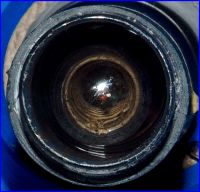
The fill gas is Ne/Br, and when viewed in darkness, flashes of reddish light can be seen with each Townsend avalanche - an opportunity perhaps to take off the signal with a PIN photodiode, when good use could be made of the opaque black rubber jacket to exclude all ambient liqht.
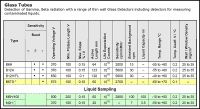
Proud Mary, Thu Jan 19 2012, 09:12PM
Centronics M2H (UK MOD CV2886) glass beta-gamma detector for sampling liquids
Another member of the Centronics glass beta-gamma detector family
This rubbery old horror was designed as an accessory for Meter, Contamination, No. 1 set, in 1953, so it's a bit of a surprise to find it still in the Centronics product guide.
M2H was intended for liquid sampling in Cold War doomsday applications. The end cap was removed while worried soldiers dribbled the suspect liquid into the space between the clear plastic container and the glass tube.

The base plugs into the ancient and absurdly expensive B2 (British 2-pin) socket, still widely used for GM tubes, whilst long obsolete everywhere else.

In the open end view below we can see the helical structure of the M2H cathode - as with B12H above - perhaps explaining the 'H' suffix. It looks as if it would be impossible to thoroughly decontaminate the sampling chamber after exposure to the highly radioactive liquids consequent upon a 1950s "A-bomb" blast, a shortcoming which also limits the use of M2H for accurate scientific work.
Of course, when using M2H as a general purpose gamma-only detector, there's no reason at all to remove the rubber cap.

The fill gas is Ne/Br, and when viewed in darkness, flashes of reddish light can be seen with each Townsend avalanche - an opportunity perhaps to take off the signal with a PIN photodiode, when good use could be made of the opaque black rubber jacket to exclude all ambient liqht.

Re: What are the most interesting vacuum tubes in your collection?
radhoo, Thu Jan 26 2012, 05:14PM
A huge GM tube, containing 10 detectors and a mica window, here is the russian SBT-10A . The A model comes with several improvements over the original non-A design.
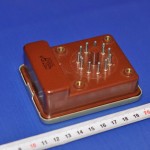
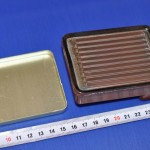
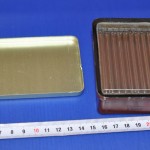
The tube runs at 390 V. Datasheet here:
radhoo, Thu Jan 26 2012, 05:14PM
A huge GM tube, containing 10 detectors and a mica window, here is the russian SBT-10A . The A model comes with several improvements over the original non-A design.



The tube runs at 390 V. Datasheet here:

Re: What are the most interesting vacuum tubes in your collection?
radhoo, Thu Jan 26 2012, 05:41PM
Here are three VFD tubes (Vacuum fluorescent display),
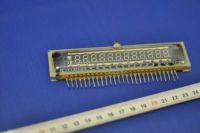
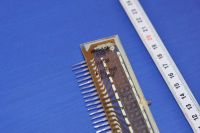
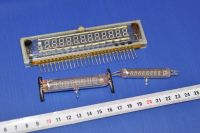
Some details here:
radhoo, Thu Jan 26 2012, 05:41PM
Here are three VFD tubes (Vacuum fluorescent display),



Some details here:

Re: What are the most interesting vacuum tubes in your collection?
Proud Mary, Thu Jan 26 2012, 09:32PM
What a wonderful device! You can switch from coincidence to anti-coincidence counting, run both modes at the same time, or just run the ten devices in parallel to increase the aperture or capture area. ! I've heard about these but never seen one before. Thank you for posting it!
Proud Mary, Thu Jan 26 2012, 09:32PM
radhoo wrote ...
A huge GM tube, containing 10 detectors and a mica window, here is the russian SBT-10A . The A model comes with several improvements over the original non-A design.



The tube runs at 390 V. Datasheet here:
A huge GM tube, containing 10 detectors and a mica window, here is the russian SBT-10A . The A model comes with several improvements over the original non-A design.



The tube runs at 390 V. Datasheet here:

What a wonderful device! You can switch from coincidence to anti-coincidence counting, run both modes at the same time, or just run the ten devices in parallel to increase the aperture or capture area. ! I've heard about these but never seen one before. Thank you for posting it!

Re: What are the most interesting vacuum tubes in your collection?
1n5ane, Tue Feb 07 2012, 10:36PM
Here's part of my power tube collection:
4-1000A: Transmitter tetrode, Pa=1kW

4-250A: Transmitter tetrode, Pa=250W
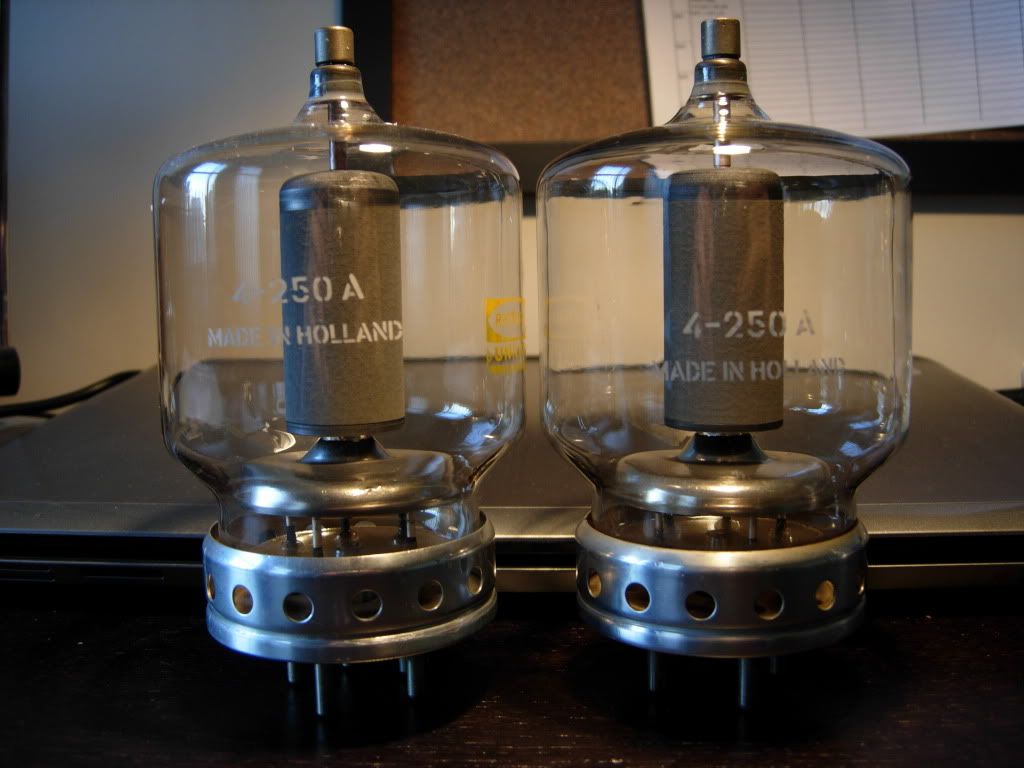
4-125A: Transmitter tetrode, Pa=125W
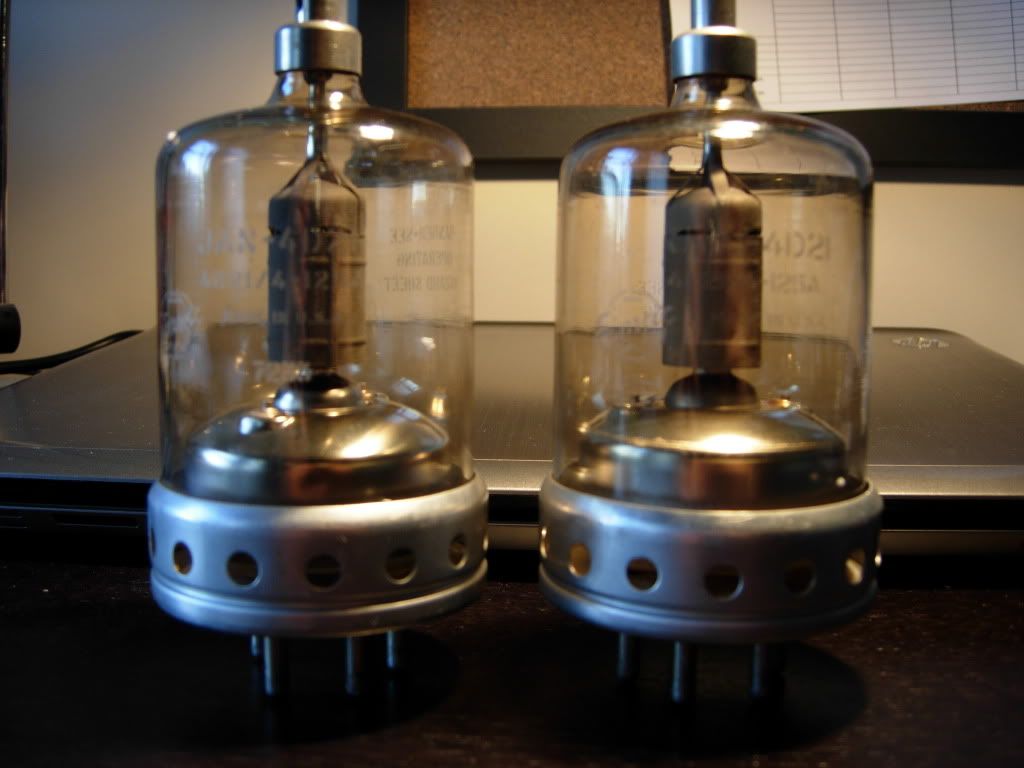
4-65A: Transmitter tetrode, Pa=65W

Family photo:
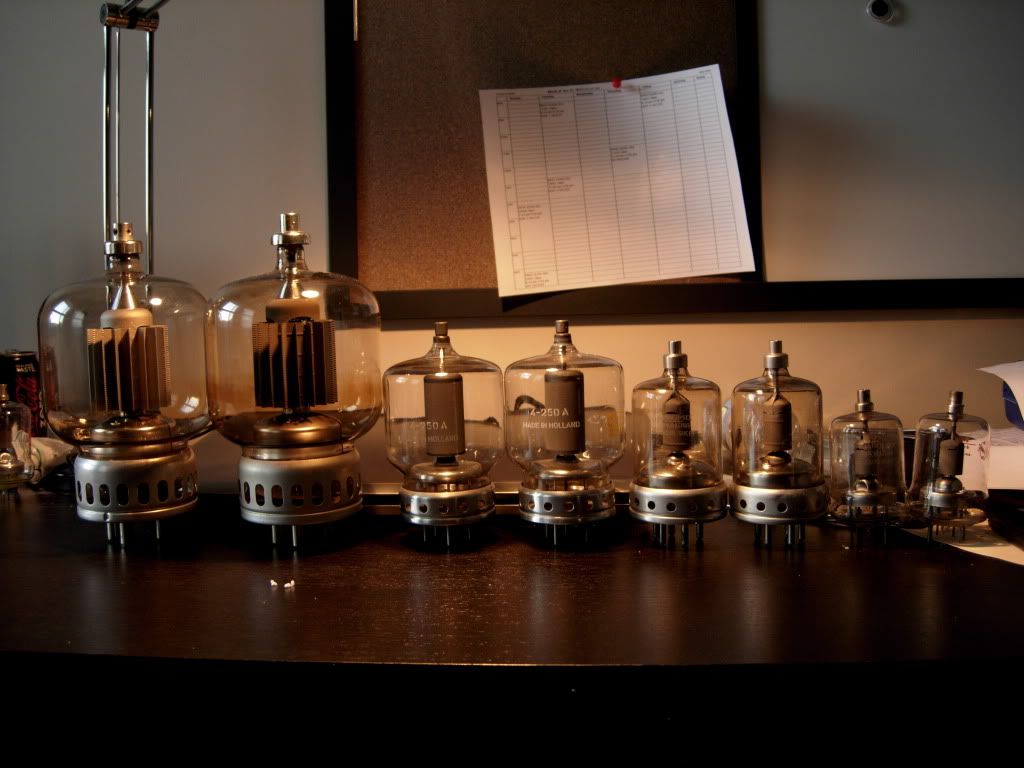
All the tubes are functional. I haven't been able to find a 4-400A(cheap enough) to complete to family.
[Edit: Size]
1n5ane, Tue Feb 07 2012, 10:36PM
Here's part of my power tube collection:
4-1000A: Transmitter tetrode, Pa=1kW

4-250A: Transmitter tetrode, Pa=250W

4-125A: Transmitter tetrode, Pa=125W

4-65A: Transmitter tetrode, Pa=65W

Family photo:

All the tubes are functional. I haven't been able to find a 4-400A(cheap enough) to complete to family.
[Edit: Size]
Re: What are the most interesting vacuum tubes in your collection?
Proud Mary, Wed Feb 08 2012, 12:27AM
Dave: a beautiful collection in lovely condition.
Proud Mary, Wed Feb 08 2012, 12:27AM
Dave: a beautiful collection in lovely condition.
Re: What are the most interesting vacuum tubes in your collection?
Proud Mary, Wed Feb 08 2012, 07:18PM
PMT FeU-29

This handy photomultiplier has 13 dynodes, and the two radial terminals are cathode and anode. The base is a Russian 14-pin with central spigot.
Spectral sensitivity is in the range 300 - 600nm, with peak sensitvity lying through 380 - 420nm - across the UV to violet transition.
Gain increases with anode voltage, being a modest 1*10E5 at 860 V, rising to a sensitive 1*10E7 at 1.360 kV.
Proud Mary, Wed Feb 08 2012, 07:18PM
PMT FeU-29

This handy photomultiplier has 13 dynodes, and the two radial terminals are cathode and anode. The base is a Russian 14-pin with central spigot.
Spectral sensitivity is in the range 300 - 600nm, with peak sensitvity lying through 380 - 420nm - across the UV to violet transition.
Gain increases with anode voltage, being a modest 1*10E5 at 860 V, rising to a sensitive 1*10E7 at 1.360 kV.
Re: What are the most interesting vacuum tubes in your collection?
Proud Mary, Fri Feb 24 2012, 01:20PM
GS4V Microwave Triode 15W 7.5 GHz
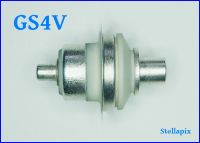
This tiny ceramic triode is 31mm from tip to tip and weighs just 12 gm, but can deliver 15W at up to 7.5 GHz in Class C oscillator/amplifier applications using co-axial resonators.
Heater voltage is 6.3V, typical anode voltage is 200V, and mutual conductance is 15 - 18 mA/V.
Cooling is forced air.
Verdict: an astonishing little device! A must have for the recreational plumber!
Proud Mary, Fri Feb 24 2012, 01:20PM
GS4V Microwave Triode 15W 7.5 GHz

This tiny ceramic triode is 31mm from tip to tip and weighs just 12 gm, but can deliver 15W at up to 7.5 GHz in Class C oscillator/amplifier applications using co-axial resonators.
Heater voltage is 6.3V, typical anode voltage is 200V, and mutual conductance is 15 - 18 mA/V.
Cooling is forced air.
Verdict: an astonishing little device! A must have for the recreational plumber!
Re: What are the most interesting vacuum tubes in your collection?
Proud Mary, Fri Feb 24 2012, 06:31PM
6S9D UHF Triode 5.5W 900 Mhz
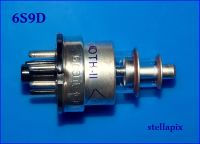
This gorgeous Russian triode can deliver up to 5.5W at 900 MHz, in Class C oscillator/amplifier applications, with co-axial resonators.
Heater voltage is 6.3V with 'typical' anode voltage 250V at 15mA ± 7mA.
The base is international octal, weight is 40 gm, and guaranteed minimum service life is 600 hr.
Another must have for people who enjoy the copper pipe and brazing torch approach to tuned circuits.
Proud Mary, Fri Feb 24 2012, 06:31PM
6S9D UHF Triode 5.5W 900 Mhz

This gorgeous Russian triode can deliver up to 5.5W at 900 MHz, in Class C oscillator/amplifier applications, with co-axial resonators.
Heater voltage is 6.3V with 'typical' anode voltage 250V at 15mA ± 7mA.
The base is international octal, weight is 40 gm, and guaranteed minimum service life is 600 hr.
Another must have for people who enjoy the copper pipe and brazing torch approach to tuned circuits.
Re: What are the most interesting vacuum tubes in your collection?
Proud Mary, Sat Feb 25 2012, 10:15PM
3C24 RF Power Triode

This remarkably compact relic of the Second World War can output 100W of RF as Class 'C' oscillator/amplifier with 2kV on the anode.
Unsurprisingly for a valve that dissipates 25W at the anode, but is only 111 mm high, the datasheet advises that "Heat dissipating connections of large area are necessary for anode and grid."
The UK military designation for 3C24 is CV789, together with CV2736 where they are supplied in matched pairs. One can easily imagine them huffing and puffing, backwards and forwards with the electron stream when two are working in push-pull.
Heater is 6.3V/3A and the base is Small UX4.
Proud Mary, Sat Feb 25 2012, 10:15PM
3C24 RF Power Triode

This remarkably compact relic of the Second World War can output 100W of RF as Class 'C' oscillator/amplifier with 2kV on the anode.
Unsurprisingly for a valve that dissipates 25W at the anode, but is only 111 mm high, the datasheet advises that "Heat dissipating connections of large area are necessary for anode and grid."
The UK military designation for 3C24 is CV789, together with CV2736 where they are supplied in matched pairs. One can easily imagine them huffing and puffing, backwards and forwards with the electron stream when two are working in push-pull.
Heater is 6.3V/3A and the base is Small UX4.
Re: What are the most interesting vacuum tubes in your collection?
Dr. Dark Current, Thu Mar 01 2012, 01:19PM
Here's my tube collection of now, needed to take them out of my room as it's a real mess

Dr. Dark Current, Thu Mar 01 2012, 01:19PM
Here's my tube collection of now, needed to take them out of my room as it's a real mess


Re: What are the most interesting vacuum tubes in your collection?
Proud Mary, Tue Mar 06 2012, 07:25PM
V2V-1V Vacuum Relay 4kV 15A
(B2B-1B in Russian Cyrillic characters)
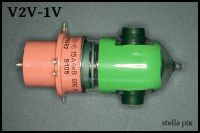
The gap between the armature plate and the face of the solenoid in the base snaps shut when 12 VDC is applied to the two base pins
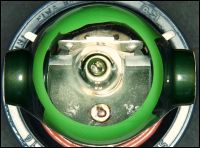
Top view showing internal relay contacts. The moving contacts are operated by a simple lever connected to the armature plate.
This unit came from an original unopened box dated May 1991, so the sputter deposits seen around the right hand contact can only have come from
quality control testing or burning-in at the Russian factory.
Proud Mary, Tue Mar 06 2012, 07:25PM
V2V-1V Vacuum Relay 4kV 15A
(B2B-1B in Russian Cyrillic characters)

The gap between the armature plate and the face of the solenoid in the base snaps shut when 12 VDC is applied to the two base pins

Top view showing internal relay contacts. The moving contacts are operated by a simple lever connected to the armature plate.
This unit came from an original unopened box dated May 1991, so the sputter deposits seen around the right hand contact can only have come from
quality control testing or burning-in at the Russian factory.
Re: What are the most interesting vacuum tubes in your collection?
Conundrum, Wed Mar 07 2012, 10:51PM
LOL! "In Soviet Russia, tube burns you in!! "
Still can't figure out a use for the 30 or so mercury wetted vacuum relays I found in a random box of parts.
-A
Conundrum, Wed Mar 07 2012, 10:51PM
LOL! "In Soviet Russia, tube burns you in!! "

Still can't figure out a use for the 30 or so mercury wetted vacuum relays I found in a random box of parts.
-A
Re: What are the most interesting vacuum tubes in your collection?
Proud Mary, Thu Mar 08 2012, 01:36AM
Mercury-Argon Thyratron 393A
British military No. CV 2638
Argon is used in this design to initiate a plasma discharge at a lower temperature than would be possible using mercury alone. Once running, it behaves as a mercury vapour device, with the usual 10V voltage drop across it.
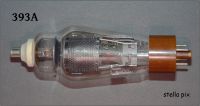
The speckles of black and silver on the inside of the glass are condensed mercury.
The gauze holder of the mercury heater seen in profile in the top picture is shown in detail below.
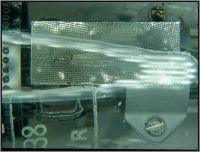
This is a slow old negative-control thyratron - de-ionisation time is a leisurely 60 μs at best - but its charm lies in the hand built nuts-and-bolts construction inside the glass envelope.
Maximum anode voltage is 1200V at 6A peak, grid voltage is down to -500V, and the heater is 2.5V/7A.
Mounting must be vertical to accomodate the condensed mercury, and the base is International Octal.
Proud Mary, Thu Mar 08 2012, 01:36AM
Mercury-Argon Thyratron 393A
British military No. CV 2638
Argon is used in this design to initiate a plasma discharge at a lower temperature than would be possible using mercury alone. Once running, it behaves as a mercury vapour device, with the usual 10V voltage drop across it.

The speckles of black and silver on the inside of the glass are condensed mercury.
The gauze holder of the mercury heater seen in profile in the top picture is shown in detail below.

This is a slow old negative-control thyratron - de-ionisation time is a leisurely 60 μs at best - but its charm lies in the hand built nuts-and-bolts construction inside the glass envelope.
Maximum anode voltage is 1200V at 6A peak, grid voltage is down to -500V, and the heater is 2.5V/7A.
Mounting must be vertical to accomodate the condensed mercury, and the base is International Octal.
Re: What are the most interesting vacuum tubes in your collection?
Proud Mary, Thu Mar 08 2012, 05:26PM
DL73 miniature VHF directly heated power pentode
This terrific little battery pentode was designed for use in "communications equipment of the 'push to talk' type" - in a word, early military walkie-talkies.
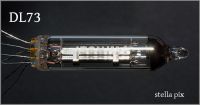
Power requirements are 150V/18mA anode, -20V grid bias, and 1.25V/200mA filament.
Output is 1.6W at 50MHz falling to 1.2W at 200MHz as Class "C" power amp.
Great stuff for a valve no thicker than a pencil, but operating life in push to talk service is short: just 200 hours.
Proud Mary, Thu Mar 08 2012, 05:26PM
DL73 miniature VHF directly heated power pentode
This terrific little battery pentode was designed for use in "communications equipment of the 'push to talk' type" - in a word, early military walkie-talkies.

Power requirements are 150V/18mA anode, -20V grid bias, and 1.25V/200mA filament.
Output is 1.6W at 50MHz falling to 1.2W at 200MHz as Class "C" power amp.
Great stuff for a valve no thicker than a pencil, but operating life in push to talk service is short: just 200 hours.
Re: What are the most interesting vacuum tubes in your collection?
Luceš, Sat Mar 10 2012, 02:32AM
what about your gu-80? that is probably one of your most rare tubes!
Luceš, Sat Mar 10 2012, 02:32AM
Dr. Dark Current wrote ...
Here's my tube collection of now, needed to take them out of my room as it's a real mess

Here's my tube collection of now, needed to take them out of my room as it's a real mess


what about your gu-80? that is probably one of your most rare tubes!
Re: What are the most interesting vacuum tubes in your collection?
Dr. Dark Current, Sat Mar 10 2012, 01:45PM
Hi Luceš,
I exchanged th GU-80 with a friend for a GU-81 a long time ago, I needed two 81's for a VTTC. The GU-80 is still pretty common around here, the 81 is superior, and I think there are more rare tubes in my collection than the GU80.
Dr. Dark Current, Sat Mar 10 2012, 01:45PM
Hi Luceš,
I exchanged th GU-80 with a friend for a GU-81 a long time ago, I needed two 81's for a VTTC. The GU-80 is still pretty common around here, the 81 is superior, and I think there are more rare tubes in my collection than the GU80.
Re: What are the most interesting vacuum tubes in your collection?
Proud Mary, Sat Mar 10 2012, 02:05PM
Kilovac H-8 Vacuum Relay SPST 12kV
Radial view
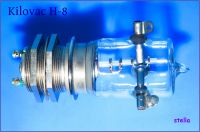
Axial view

12 kV is maximum hot switching voltage.
Actuator voltage is 26.5V, winding resistance 265Ω.
Proud Mary, Sat Mar 10 2012, 02:05PM
Kilovac H-8 Vacuum Relay SPST 12kV
Radial view

Axial view

12 kV is maximum hot switching voltage.
Actuator voltage is 26.5V, winding resistance 265Ω.
Re: What are the most interesting vacuum tubes in your collection?
Dr. Dark Current, Thu Apr 05 2012, 10:26PM
GM100: A really oversized triode (note the standard "noval" tube for size comparison), with 1 kW of plate dissipation. Has pure tungsten cathode so not much emission, can you think of any cool use?
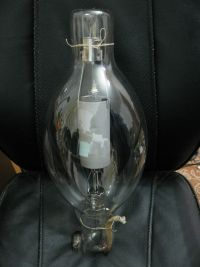
Dr. Dark Current, Thu Apr 05 2012, 10:26PM
GM100: A really oversized triode (note the standard "noval" tube for size comparison), with 1 kW of plate dissipation. Has pure tungsten cathode so not much emission, can you think of any cool use?

Re: What are the most interesting vacuum tubes in your collection?
radhoo, Tue Jun 05 2012, 08:09PM
Interesting colors!
radhoo, Tue Jun 05 2012, 08:09PM
Interesting colors!
Re: What are the most interesting vacuum tubes in your collection?
Conundrum, Tue Jun 05 2012, 08:45PM
Shall I post the picture of that "flat" CRT?
-A
Conundrum, Tue Jun 05 2012, 08:45PM
Shall I post the picture of that "flat" CRT?
-A
Re: What are the most interesting vacuum tubes in your collection?
radhoo, Sun Sept 02 2012, 12:33PM
ZV 1009 "Velocitron" Klystron
Filament Vf 6.3 Volts / If: 0.68 Ampere / -: Indirect /
Description Metal-ceramic klystron, derived from 6BL6; 1500 to 6000 MHz; can be operated CW, pulsed or FM. Pee-wee 4 pin base; external cavity. Made to Polarad specs under WE patents.
Pin 1 - control electrode, pin 2,4 - heater, pin 3 - cathode; resonator grids to the two rings on the body; reflector to cap.
Info taken from:
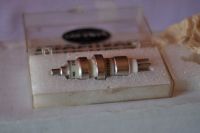
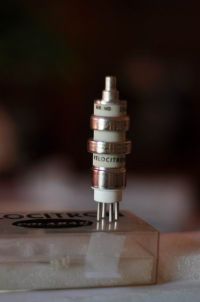
radhoo, Sun Sept 02 2012, 12:33PM
ZV 1009 "Velocitron" Klystron
Filament Vf 6.3 Volts / If: 0.68 Ampere / -: Indirect /
Description Metal-ceramic klystron, derived from 6BL6; 1500 to 6000 MHz; can be operated CW, pulsed or FM. Pee-wee 4 pin base; external cavity. Made to Polarad specs under WE patents.
Pin 1 - control electrode, pin 2,4 - heater, pin 3 - cathode; resonator grids to the two rings on the body; reflector to cap.
Info taken from:



Re: What are the most interesting vacuum tubes in your collection?
radhoo, Sun Sept 02 2012, 01:00PM
EMI 9524 Photomultiplier



EMI photomuliplier tube type 9524S (ser no 60678). 14 pin base.
30mm diameter, 112mm long, 11 dynodes, responds to light wavelengths from 320nm to 630nm.
Low dark current, typical sensitivity 50uA/lm, 20.5% peak Q.E.
Lime soda glass window, S-11 type photocatode; 11 dynodes coated with CsSb. 14 pin, B14B base. Intended for scintillation counter applications.
EMI/US, North Hollywood, CA, USA, known manufacturer.
radhoo, Sun Sept 02 2012, 01:00PM
EMI 9524 Photomultiplier



EMI photomuliplier tube type 9524S (ser no 60678). 14 pin base.
30mm diameter, 112mm long, 11 dynodes, responds to light wavelengths from 320nm to 630nm.
Low dark current, typical sensitivity 50uA/lm, 20.5% peak Q.E.
Lime soda glass window, S-11 type photocatode; 11 dynodes coated with CsSb. 14 pin, B14B base. Intended for scintillation counter applications.
EMI/US, North Hollywood, CA, USA, known manufacturer.
Re: What are the most interesting vacuum tubes in your collection?
2Spoons, Tue Sept 04 2012, 05:11AM
GU-81M pentode, 300pF 15kV vacuum capacitor, and an A101 Dekatron counting tube.
Somewhere I have a box full of old radio tubes my grandfather gave me - must trawl through and see whats in there.
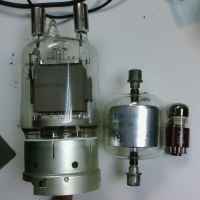
2Spoons, Tue Sept 04 2012, 05:11AM
GU-81M pentode, 300pF 15kV vacuum capacitor, and an A101 Dekatron counting tube.
Somewhere I have a box full of old radio tubes my grandfather gave me - must trawl through and see whats in there.

Re: What are the most interesting vacuum tubes in your collection?
radhoo, Wed Sept 05 2012, 07:36AM
UX-6653, Raytheon, 1941

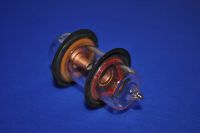

TR-Switch tube used in Radar. I am looking for its datasheet, does anyone have it?
radhoo, Wed Sept 05 2012, 07:36AM
UX-6653, Raytheon, 1941



TR-Switch tube used in Radar. I am looking for its datasheet, does anyone have it?
Re: What are the most interesting vacuum tubes in your collection?
Proud Mary, Sat Sept 08 2012, 07:17PM
I don't have the data sheet, unfortunately, Radhu, but I can say a few things about your device which may help you.
This device is made to be installed in a rectangular waveguide. The distance between the two external disc seals is the short height of rectangular waveguide. The disc seals would have fitted into machined and rabetted holes in the waveguide wall.
As you now know the height of the waveguide cross section, you can look it up in a table of waveguide dimensions to find the frequency range.
Later TR switches were fitted with a separate HT terminal supplied from a high Z source of a few kV.
In your case, I suggest you connect the disc seals across a high Z variable supply (put in a high value resistor as with neons) and turn up the voltage until the gap just begins to glow (in the dark). Back off a little way from this, and that will be your keep alive voltage.
With no keep-alive voltage, ionisation will not occur quickly enough to short out the waveguide, and the leading edge of the microwave pulse will get through and destroy the receiver.
The cathode is the hollow electrode.
As a guess only, and by the look of the thing, I would expect it was designed for operation at perhaps 3 GHz, but you must make your measurements to find out.
Proud Mary, Sat Sept 08 2012, 07:17PM
radhoo wrote ...
TR-Switch tube used in Radar. I am looking for its datasheet, does anyone have it?
TR-Switch tube used in Radar. I am looking for its datasheet, does anyone have it?
I don't have the data sheet, unfortunately, Radhu, but I can say a few things about your device which may help you.
This device is made to be installed in a rectangular waveguide. The distance between the two external disc seals is the short height of rectangular waveguide. The disc seals would have fitted into machined and rabetted holes in the waveguide wall.
As you now know the height of the waveguide cross section, you can look it up in a table of waveguide dimensions to find the frequency range.
Later TR switches were fitted with a separate HT terminal supplied from a high Z source of a few kV.
In your case, I suggest you connect the disc seals across a high Z variable supply (put in a high value resistor as with neons) and turn up the voltage until the gap just begins to glow (in the dark). Back off a little way from this, and that will be your keep alive voltage.
With no keep-alive voltage, ionisation will not occur quickly enough to short out the waveguide, and the leading edge of the microwave pulse will get through and destroy the receiver.
The cathode is the hollow electrode.
As a guess only, and by the look of the thing, I would expect it was designed for operation at perhaps 3 GHz, but you must make your measurements to find out.

Re: What are the most interesting vacuum tubes in your collection?
radhoo, Tue Sept 11 2012, 11:44AM
That is a valuable piece of information, thank you, Stella.
My Sinometer VC2000 unfortunately stops at 2.4GHz, making my work in this area a bit more difficult. Perhaps I will get back to some of my other tubes, that can work at a smaller frequency, such as some of the Klystron tubes that are still waiting for some of my time.
Here are some of my hottest tubes:
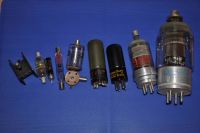
Of course, being hot refers to the radiation emitted as most of these are radionuclide enhanced ionization tubes.
I've recorded a few videos showing the dose, I just need to put them together and will be posting them here.
From right to the left:
1. JAN4C35A, this is a Hydrogen Thyratron for radar modulation applications. 8KV peak, 100mA average, 90A peak anode current. The top seal uses Uranium Glass, making it radioactive. 0.90uSv/h right near the uranium glass.
2. JAN8370, another Hydrogen Thyratron, dating back to 1924. Again the top glass is Uranium glass. 0.80uSv/h
3. 313CD, Cold cathode neon triode, from 1952. 200V, 25mA. Kr-85 activator . No longer radioactive, at least not detectable outside the tube. Probably due to krypton's short life.
4. JAN346B, Cold cathode neon triode relay from 1924. 225V, 30mA; Average life 10Hours. One of the hottest tubes, thanks to the Radium Bromide (RaBr ) it contains. Datasheet here: 2.40uSv/h
2.40uSv/h
5. 1B26, TR Switch tube, the smaller variant of the 1B24. K-band 23.6 to 24.6GHz, integral cavity, tunable TR switch.
This tube was developed by Westinghouse under the guide of C. W. Zabel of the MIT Radiation Lab.
Details on TR Switches here: . Contains RaBr. 3.0uSv/h
. Contains RaBr. 3.0uSv/h
6. Eii-43-100 Spark gap radioactive tube, Cs137, still very active 3.5uSv/h
7. 11TN40 , not showing any detectable outside emissions. I am looking for some info on this tube, if anyone has anything..
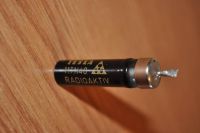
8. TG-77 Signalite Spark gap radioactive tube, Cs137, 1.7uSv/h
9. MA340F TR Switch, it was probably using Cobalt 60, so not radioactive anymore.
10. 1B22. Argon-Hydrogen filled spark gap, for use as radar modulator. Corona trigger electrode inside the cathode, to start the firing. Aluminum cathode, nickel or iron anode. By design the tube must be operated with the cathode opening downward; the aluminum eroded by sparks is mostly transferred to anode, leaving approximately constant the electrode spacing through the useful life.
2.7KV per gap firing voltage, 75A peak, 75mA average, 1100pps max.
Introduced by WE during WWII. Registered in 1948, when already discontinued. Third issue of datasheet dated 1943.
Some sources indicate it contained up to 3uCi of Ra226, probably as RaBr.
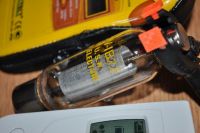
radhoo, Tue Sept 11 2012, 11:44AM
That is a valuable piece of information, thank you, Stella.
My Sinometer VC2000 unfortunately stops at 2.4GHz, making my work in this area a bit more difficult. Perhaps I will get back to some of my other tubes, that can work at a smaller frequency, such as some of the Klystron tubes that are still waiting for some of my time.
Here are some of my hottest tubes:

Of course, being hot refers to the radiation emitted as most of these are radionuclide enhanced ionization tubes.
I've recorded a few videos showing the dose, I just need to put them together and will be posting them here.
From right to the left:
1. JAN4C35A, this is a Hydrogen Thyratron for radar modulation applications. 8KV peak, 100mA average, 90A peak anode current. The top seal uses Uranium Glass, making it radioactive. 0.90uSv/h right near the uranium glass.
2. JAN8370, another Hydrogen Thyratron, dating back to 1924. Again the top glass is Uranium glass. 0.80uSv/h
3. 313CD, Cold cathode neon triode, from 1952. 200V, 25mA. Kr-85 activator . No longer radioactive, at least not detectable outside the tube. Probably due to krypton's short life.
4. JAN346B, Cold cathode neon triode relay from 1924. 225V, 30mA; Average life 10Hours. One of the hottest tubes, thanks to the Radium Bromide (RaBr ) it contains. Datasheet here:
 2.40uSv/h
2.40uSv/h5. 1B26, TR Switch tube, the smaller variant of the 1B24. K-band 23.6 to 24.6GHz, integral cavity, tunable TR switch.
This tube was developed by Westinghouse under the guide of C. W. Zabel of the MIT Radiation Lab.
Details on TR Switches here:
 . Contains RaBr. 3.0uSv/h
. Contains RaBr. 3.0uSv/h6. Eii-43-100 Spark gap radioactive tube, Cs137, still very active 3.5uSv/h
7. 11TN40 , not showing any detectable outside emissions. I am looking for some info on this tube, if anyone has anything..

8. TG-77 Signalite Spark gap radioactive tube, Cs137, 1.7uSv/h
9. MA340F TR Switch, it was probably using Cobalt 60, so not radioactive anymore.
10. 1B22. Argon-Hydrogen filled spark gap, for use as radar modulator. Corona trigger electrode inside the cathode, to start the firing. Aluminum cathode, nickel or iron anode. By design the tube must be operated with the cathode opening downward; the aluminum eroded by sparks is mostly transferred to anode, leaving approximately constant the electrode spacing through the useful life.
2.7KV per gap firing voltage, 75A peak, 75mA average, 1100pps max.
Introduced by WE during WWII. Registered in 1948, when already discontinued. Third issue of datasheet dated 1943.
Some sources indicate it contained up to 3uCi of Ra226, probably as RaBr.

Re: What are the most interesting vacuum tubes in your collection?
Proud Mary, Tue Sept 11 2012, 06:46PM
I've got two 4C35A thyratrons, but I never knew about the U glass in the top seal! I shall have to take a measurement of it when I have finished painting my house.
Proud Mary, Tue Sept 11 2012, 06:46PM
I've got two 4C35A thyratrons, but I never knew about the U glass in the top seal! I shall have to take a measurement of it when I have finished painting my house.
Re: What are the most interesting vacuum tubes in your collection?
radhoo, Tue Sept 11 2012, 09:00PM


Left picture: 4C35A Right:JAN8370
The uranium glass green fluorescence under UV, is clearly visible.
radhoo, Tue Sept 11 2012, 09:00PM
Proud Mary wrote ...
I've got two 4C35A thyratrons, but I never knew about the U glass in the top seal! I shall have to take a measurement of it when I have finished painting my house.
Yes and it's quite active, at least when compared to other uranium glass samples I tested. I didn't have the time to finish the video featuring these tubes, but regarding the two thyratrons, here is how they look under UV:I've got two 4C35A thyratrons, but I never knew about the U glass in the top seal! I shall have to take a measurement of it when I have finished painting my house.


Left picture: 4C35A Right:JAN8370
The uranium glass green fluorescence under UV, is clearly visible.
Re: What are the most interesting vacuum tubes in your collection?
radhoo, Wed Sept 12 2012, 07:37AM
I found a fragment of 11TN40 's datasheet. But I still don't know what radionuclide was used in this tube.

Long time ago, I got in contact with several similar tubes. Russian or Czech, I don't know. I remember they were same format and size, except the little protuberance at one end, they looked like fuses, and were painted red or green, having the trefoil on the side. Despite the tick case, I managed to open a few. Now I'm trying to find out what was inside.
radhoo, Wed Sept 12 2012, 07:37AM
I found a fragment of 11TN40 's datasheet. But I still don't know what radionuclide was used in this tube.

Long time ago, I got in contact with several similar tubes. Russian or Czech, I don't know. I remember they were same format and size, except the little protuberance at one end, they looked like fuses, and were painted red or green, having the trefoil on the side. Despite the tick case, I managed to open a few. Now I'm trying to find out what was inside.
Re: What are the most interesting vacuum tubes in your collection?
radhoo, Wed Sept 12 2012, 08:23AM
I found the device in which the 11TN40 was used. Named BS2, of Czech origin. But I still don't know what's inside that tube.
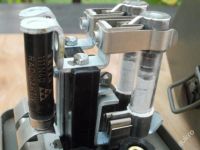

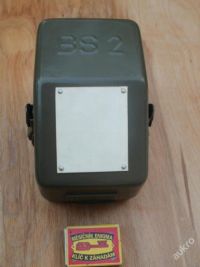
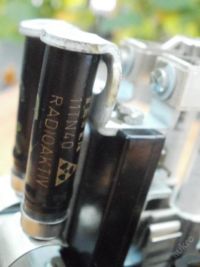
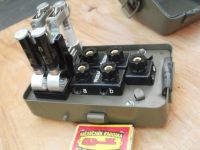
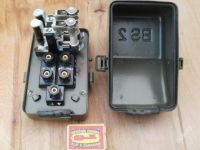
VEDENI means "LED"
PRISTOJ means "Standing Position"
radhoo, Wed Sept 12 2012, 08:23AM
I found the device in which the 11TN40 was used. Named BS2, of Czech origin. But I still don't know what's inside that tube.






VEDENI means "LED"
PRISTOJ means "Standing Position"
Re: What are the most interesting vacuum tubes in your collection?
Proud Mary, Wed Sept 12 2012, 09:19AM
I'd say that 11TN40 was a mains supply anti-surge/spike suppressors with the radionuclide added to create pre-ionisation conditions to speed up the switching action.
Working voltage 250V
Ignition (clamping) voltage 400V
Drop out voltage 200V
Peak surge voltage maximum 1000V for 50μs
Maximum conduction current 40A for 0.25 seconds.
So it will ignite (zápal) at 400V and conduct until the voltage falls to 200V.
I'd guess that the radionuclide would be an alpha or beta emitter, as these can cause strong local ionization in the gap without being able to escape from the envelope in much quantity, if at all. Any gamma emission will be an unwanted by-product.
(I use a small piece of pitchblende - uraninite - as my test source, as this is not controlled by the UK Government due to the Geological Specimens Exemption Order 1962 and so does not have to be registered under the Radioactive Substances Act 1993.)
Proud Mary, Wed Sept 12 2012, 09:19AM
I'd say that 11TN40 was a mains supply anti-surge/spike suppressors with the radionuclide added to create pre-ionisation conditions to speed up the switching action.
Working voltage 250V
Ignition (clamping) voltage 400V
Drop out voltage 200V
Peak surge voltage maximum 1000V for 50μs
Maximum conduction current 40A for 0.25 seconds.
So it will ignite (zápal) at 400V and conduct until the voltage falls to 200V.
I'd guess that the radionuclide would be an alpha or beta emitter, as these can cause strong local ionization in the gap without being able to escape from the envelope in much quantity, if at all. Any gamma emission will be an unwanted by-product.
(I use a small piece of pitchblende - uraninite - as my test source, as this is not controlled by the UK Government due to the Geological Specimens Exemption Order 1962 and so does not have to be registered under the Radioactive Substances Act 1993.)
Re: What are the most interesting vacuum tubes in your collection?
Proud Mary, Wed Sept 12 2012, 09:21AM
I never stopped to think why the top of the envelope was a strange colour! I will put up a photo and measure the activity of mine when I have got through with the house decorating.
Proud Mary, Wed Sept 12 2012, 09:21AM
radhoo wrote ...


Left picture: 4C35A Right:JAN8370
The uranium glass green fluorescence under UV, is clearly visible.
Proud Mary wrote ...
I've got two 4C35A thyratrons, but I never knew about the U glass in the top seal! I shall have to take a measurement of it when I have finished painting my house.
Yes and it's quite active, at least when compared to other uranium glass samples I tested. I didn't have the time to finish the video featuring these tubes, but regarding the two thyratrons, here is how they look under UV:I've got two 4C35A thyratrons, but I never knew about the U glass in the top seal! I shall have to take a measurement of it when I have finished painting my house.


Left picture: 4C35A Right:JAN8370
The uranium glass green fluorescence under UV, is clearly visible.
I never stopped to think why the top of the envelope was a strange colour! I will put up a photo and measure the activity of mine when I have got through with the house decorating.
Re: What are the most interesting vacuum tubes in your collection?
Steve Conner, Wed Sept 12 2012, 10:05AM
The "BS2" device looks like a surge suppressor for a phone line. "Vedeni" probably means "line" and "Pristroj" "apparatus".
Maybe it was a Cold War-era gadget to protect military field telephones from EMP. Using radioactive things to protect against other radioactive things, FTW.
Steve Conner, Wed Sept 12 2012, 10:05AM
The "BS2" device looks like a surge suppressor for a phone line. "Vedeni" probably means "line" and "Pristroj" "apparatus".
Maybe it was a Cold War-era gadget to protect military field telephones from EMP. Using radioactive things to protect against other radioactive things, FTW.

Re: What are the most interesting vacuum tubes in your collection?
radhoo, Wed Sept 19 2012, 08:43AM
A 3.5KW Monster, the GU-5B triode.
This nice tube was kindly donated to me by Vasil, together with 3 tesla coil full assemblies (transformers, high voltage caps, and everything else). When one gives out of his most precious belongings, is probably the best case of magnanimity. Thanks Vasil.
The GU-5B was used in his GU5Bzilla, that I will reassemble soon:
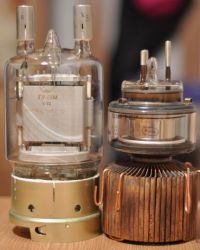
Datasheet:
radhoo, Wed Sept 19 2012, 08:43AM
A 3.5KW Monster, the GU-5B triode.
This nice tube was kindly donated to me by Vasil, together with 3 tesla coil full assemblies (transformers, high voltage caps, and everything else). When one gives out of his most precious belongings, is probably the best case of magnanimity. Thanks Vasil.
The GU-5B was used in his GU5Bzilla, that I will reassemble soon:


Datasheet:

Re: What are the most interesting vacuum tubes in your collection?
radhoo, Sun Dec 30 2012, 08:21PM
There are some electronic tubes that contain small quantities of radioactive materials to enhance the internal ionization processes. Such tubes have been used in the 20th century mostly in radar technology. Using a Geiger dosimeter, I have created a top of the tubes in my collection, based on their measured activity:
radhoo, Sun Dec 30 2012, 08:21PM
There are some electronic tubes that contain small quantities of radioactive materials to enhance the internal ionization processes. Such tubes have been used in the 20th century mostly in radar technology. Using a Geiger dosimeter, I have created a top of the tubes in my collection, based on their measured activity:
Re: What are the most interesting vacuum tubes in your collection?
Proud Mary, Mon Dec 31 2012, 10:50AM
Hi Radhu,
I got about 1.5 μSv/hr @ 10mm from the tops of my two 4C35A H2 thyratrons using a Fluke Victoreen 440RF/D ion chamber dosimeter, and about 1 μSv/hr @ 10mm using a Mini Instruments 900 series Mini Monitor with GM gamma probe.
The green uranium glass pigmentation on my 4C35As doesn't look as dense as it appears in your images, but perhaps this is just a trick of the light, or fluorescence.
At these low levels, background forms a significant percentage of the total count, so you'd need a long integration time - say 12 hours - to get much more accurate dose rate estimates than these.
Anul Nou fericit prieten vechi!
Stella
Proud Mary, Mon Dec 31 2012, 10:50AM
Hi Radhu,
I got about 1.5 μSv/hr @ 10mm from the tops of my two 4C35A H2 thyratrons using a Fluke Victoreen 440RF/D ion chamber dosimeter, and about 1 μSv/hr @ 10mm using a Mini Instruments 900 series Mini Monitor with GM gamma probe.
The green uranium glass pigmentation on my 4C35As doesn't look as dense as it appears in your images, but perhaps this is just a trick of the light, or fluorescence.
At these low levels, background forms a significant percentage of the total count, so you'd need a long integration time - say 12 hours - to get much more accurate dose rate estimates than these.
Anul Nou fericit prieten vechi!
Stella
Re: What are the most interesting vacuum tubes in your collection?
radhoo, Wed May 08 2013, 05:57PM
5J29 split anode magnetron. This device is water cooled, the water flowing round the metal loop.
Identical to 5J29 = CV3842 = ZP579
Filament Vf 2.2 Volts / If: 35 Ampere / -: Direct /
Description External magnet, split-anode, glass body CW magnetron; 350 to 770MHz; 75 to 150W out. Liquid-cooled through the anode tubular pins and the internal loop, part of the tuning line resonator.
450mA max at 2500V, 1500 gauss flux density.
Used in the AN/APT-4 jammer. 'Confidential' etched on the glass.
The 5J29 is an unusual device, a water-cooled split anode magnetron, used primarily in the AN/APT-4 radar jammer. Unlike a conventional multicavity magnetron, the 5J29 is effectively a miniature cyclotron accelerator. The 5J29 is best known as a GE product; the second-source FTR version is much rarer. The 5J29 operates at frequencies between 350 and 770MHz.

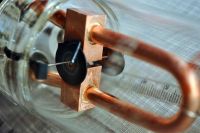
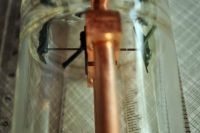
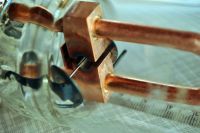
A few additional links&resources here:
radhoo, Wed May 08 2013, 05:57PM
5J29 split anode magnetron. This device is water cooled, the water flowing round the metal loop.
Identical to 5J29 = CV3842 = ZP579
Filament Vf 2.2 Volts / If: 35 Ampere / -: Direct /
Description External magnet, split-anode, glass body CW magnetron; 350 to 770MHz; 75 to 150W out. Liquid-cooled through the anode tubular pins and the internal loop, part of the tuning line resonator.
450mA max at 2500V, 1500 gauss flux density.
Used in the AN/APT-4 jammer. 'Confidential' etched on the glass.
The 5J29 is an unusual device, a water-cooled split anode magnetron, used primarily in the AN/APT-4 radar jammer. Unlike a conventional multicavity magnetron, the 5J29 is effectively a miniature cyclotron accelerator. The 5J29 is best known as a GE product; the second-source FTR version is much rarer. The 5J29 operates at frequencies between 350 and 770MHz.




A few additional links&resources here:

Re: What are the most interesting vacuum tubes in your collection?
radhoo, Thu May 09 2013, 11:09AM
External Cavity, 1KW at 1075 to 1096MHz. 'Electrodeless' discharge: the tube has the ground ring and a keep-alive electrode connection in the base. Made by Bomac and Sylvania. It measures 38x20mm (12mm across glass).

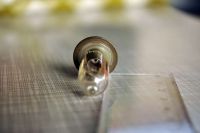
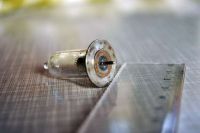


radhoo, Thu May 09 2013, 11:09AM
External Cavity, 1KW at 1075 to 1096MHz. 'Electrodeless' discharge: the tube has the ground ring and a keep-alive electrode connection in the base. Made by Bomac and Sylvania. It measures 38x20mm (12mm across glass).





Re: What are the most interesting vacuum tubes in your collection?
Proud Mary, Thu May 09 2013, 04:48PM
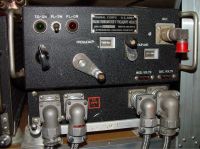
Proud Mary, Thu May 09 2013, 04:48PM
radhoo wrote ...
5J29 split anode magnetron. This device is water cooled, the water flowing round the metal loop.
Identical to 5J29 = CV3842 = ZP579
Filament Vf 2.2 Volts / If: 35 Ampere / -: Direct /
Description External magnet, split-anode, glass body CW magnetron; 350 to 770MHz; 75 to 150W out. Liquid-cooled through the anode tubular pins and the internal loop, part of the tuning line resonator.
450mA max at 2500V, 1500 gauss flux density.
Used in the AN/APT-4 jammer. 'Confidential' etched on the glass.
The 5J29 is an unusual device, a water-cooled split anode magnetron, used primarily in the AN/APT-4 radar jammer. Unlike a conventional multicavity magnetron, the 5J29 is effectively a miniature cyclotron accelerator. The 5J29 is best known as a GE product; the second-source FTR version is much rarer. The 5J29 operates at frequencies between 350 and 770MHz.




A few additional links&resources here:
5J29 split anode magnetron. This device is water cooled, the water flowing round the metal loop.
Identical to 5J29 = CV3842 = ZP579
Filament Vf 2.2 Volts / If: 35 Ampere / -: Direct /
Description External magnet, split-anode, glass body CW magnetron; 350 to 770MHz; 75 to 150W out. Liquid-cooled through the anode tubular pins and the internal loop, part of the tuning line resonator.
450mA max at 2500V, 1500 gauss flux density.
Used in the AN/APT-4 jammer. 'Confidential' etched on the glass.
The 5J29 is an unusual device, a water-cooled split anode magnetron, used primarily in the AN/APT-4 radar jammer. Unlike a conventional multicavity magnetron, the 5J29 is effectively a miniature cyclotron accelerator. The 5J29 is best known as a GE product; the second-source FTR version is much rarer. The 5J29 operates at frequencies between 350 and 770MHz.




A few additional links&resources here:


Re: What are the most interesting vacuum tubes in your collection?
macona, Mon May 13 2013, 06:36AM
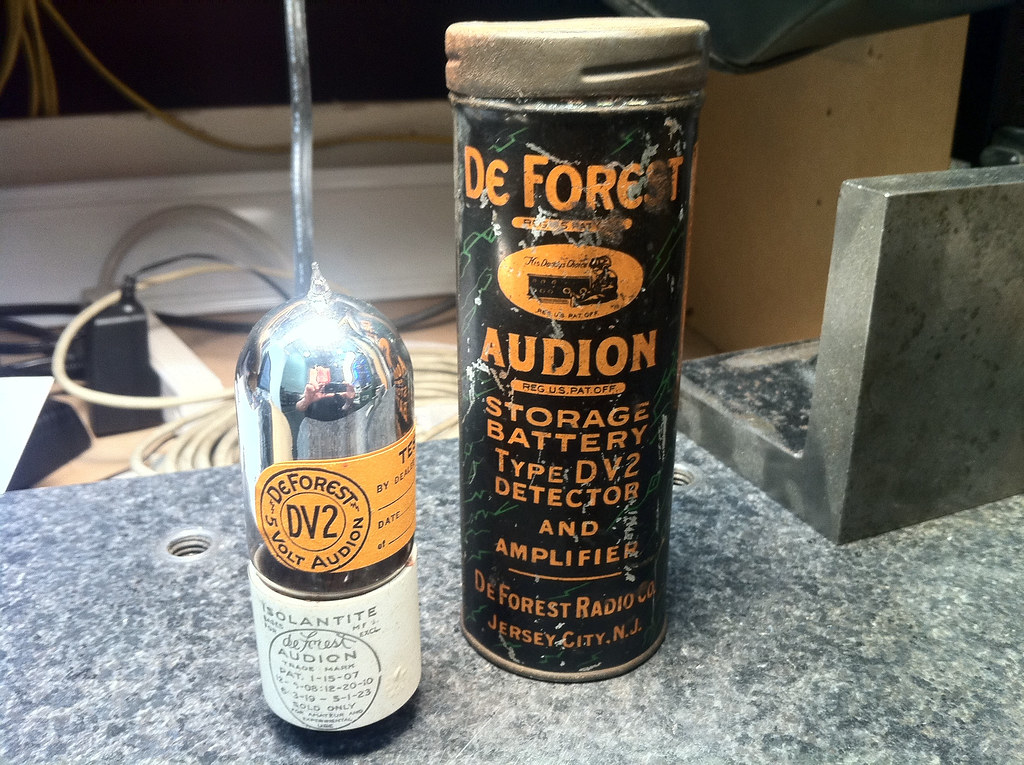
DeForest Audion DV2 vacuum tube by macona, on Flickr
macona, Mon May 13 2013, 06:36AM

DeForest Audion DV2 vacuum tube by macona, on Flickr
Re: What are the most interesting vacuum tubes in your collection?
Steve Conner, Mon May 13 2013, 11:55AM
Tre cool!
Steve Conner, Mon May 13 2013, 11:55AM
Tre cool!

Re: What are the most interesting vacuum tubes in your collection?
Dr. Dark Current, Fri May 17 2013, 12:00PM
TB5/2500 power triode with rectangular plate

RD1.5XA pure tungsten filament power triode, low velocity air flow cooling
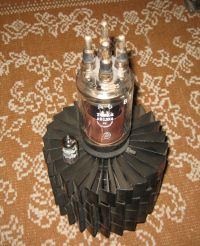
Standard telephones and cables limited 4094A made in England

Dr. Dark Current, Fri May 17 2013, 12:00PM
TB5/2500 power triode with rectangular plate

RD1.5XA pure tungsten filament power triode, low velocity air flow cooling

Standard telephones and cables limited 4094A made in England

Re: What are the most interesting vacuum tubes in your collection?
Dr. Drone, Tue May 21 2013, 10:02PM

Dr. Drone, Tue May 21 2013, 10:02PM

Re: What are the most interesting vacuum tubes in your collection?
radhoo, Sat May 25 2013, 01:52PM
Excellent stuff , guys!
A few more:
Amperex 258-B, a half-wave Mercury-Vapor, high voltage rectifier . Filament Vf 2.5 Volts / If: 7.5 Ampere . 7.5KV PIV, 640mA.
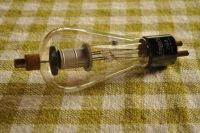
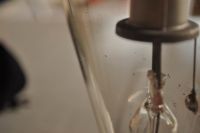
More pictures here:
Russian shunt triode, the GP-5
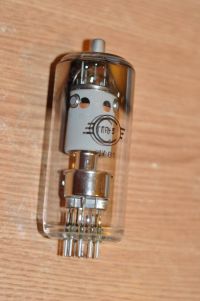

A few details on this one here:
radhoo, Sat May 25 2013, 01:52PM
Excellent stuff , guys!
A few more:
Amperex 258-B, a half-wave Mercury-Vapor, high voltage rectifier . Filament Vf 2.5 Volts / If: 7.5 Ampere . 7.5KV PIV, 640mA.


More pictures here:

Russian shunt triode, the GP-5


A few details on this one here:

Re: What are the most interesting vacuum tubes in your collection?
radhoo, Wed Jun 26 2013, 07:56PM
A geiger tube for liquids, the VAZ431:
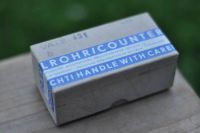
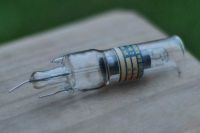
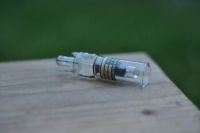
More here:
radhoo, Wed Jun 26 2013, 07:56PM
A geiger tube for liquids, the VAZ431:



More here:

Re: What are the most interesting vacuum tubes in your collection?
Proud Mary, Wed Jun 26 2013, 09:13PM
I have a Centronic M2H, which has very similar glass-work, but comes complete with a rubber jacket and an end cap tethered with a short chain, so you can't lose it. I have never had any radioactive liquid to put in it, but it works fine as a general purpose gamma detector. In a dark room, you can see tiny red neon flashes in the tube from background radiation impacts. I guess you could work with these light pulses using a PIN photodiode, and so avoid hanging any coupling capacitance on the circuit.
I couldn't think what number system VAZ431 belonged to, and then I saw 'Dresden' on the label - so East German/DDR. I believe they manufactured some interesting GM tubes. I don't know much about them, but eBay pictures I have seen show good quality modern engineering.
Proud Mary, Wed Jun 26 2013, 09:13PM
I have a Centronic M2H, which has very similar glass-work, but comes complete with a rubber jacket and an end cap tethered with a short chain, so you can't lose it. I have never had any radioactive liquid to put in it, but it works fine as a general purpose gamma detector. In a dark room, you can see tiny red neon flashes in the tube from background radiation impacts. I guess you could work with these light pulses using a PIN photodiode, and so avoid hanging any coupling capacitance on the circuit.
I couldn't think what number system VAZ431 belonged to, and then I saw 'Dresden' on the label - so East German/DDR. I believe they manufactured some interesting GM tubes. I don't know much about them, but eBay pictures I have seen show good quality modern engineering.
Re: What are the most interesting vacuum tubes in your collection?
radhoo, Fri Nov 22 2013, 11:50AM
For some time now I've been working on geiger counters, so here is yet another geiger tube, the SI-29BG and a comparison with the popular SBM-20U:
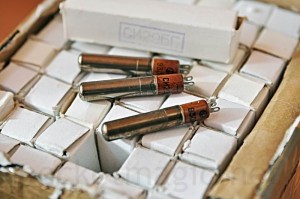
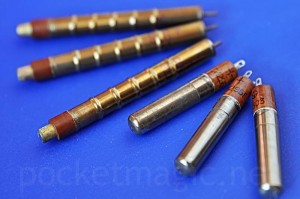
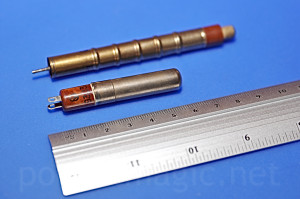
I also ran a comparison test between the two, that can be seen here
radhoo, Fri Nov 22 2013, 11:50AM
For some time now I've been working on geiger counters, so here is yet another geiger tube, the SI-29BG and a comparison with the popular SBM-20U:



I also ran a comparison test between the two, that can be seen here
Re: What are the most interesting vacuum tubes in your collection?
Proud Mary, Fri Nov 22 2013, 06:33PM
SI-29BG - It's very convenient, being single ended. You could mould a plug onto the end with epoxy, so you would have a plug in tube.
Proud Mary, Fri Nov 22 2013, 06:33PM
SI-29BG - It's very convenient, being single ended. You could mould a plug onto the end with epoxy, so you would have a plug in tube.
Re: What are the most interesting vacuum tubes in your collection?
radhoo, Tue Nov 26 2013, 09:58AM
radhoo, Tue Nov 26 2013, 09:58AM
Proud Mary wrote ...
SI-29BG - It's very convenient, being single ended. You could mould a plug onto the end with epoxy, so you would have a plug in tube.
I totally agree! I never knew it was actually so small, until I got the box.. Now I'm looking forward to finishing the PCB for it and see how it performs on the long term.SI-29BG - It's very convenient, being single ended. You could mould a plug onto the end with epoxy, so you would have a plug in tube.
Re: What are the most interesting vacuum tubes in your collection?
Proud Mary, Tue Nov 26 2013, 10:23AM
Single-ended is also good for probe applications - in liquid sampling, for example.
Proud Mary, Tue Nov 26 2013, 10:23AM
radhoo wrote ...
Proud Mary wrote ...
SI-29BG - It's very convenient, being single ended. You could mould a plug onto the end with epoxy, so you would have a plug in tube.
I totally agree! I never knew it was actually so small, until I got the box.. Now I'm looking forward to finishing the PCB for it and see how it performs on the long term.SI-29BG - It's very convenient, being single ended. You could mould a plug onto the end with epoxy, so you would have a plug in tube.
Single-ended is also good for probe applications - in liquid sampling, for example.
Re: What are the most interesting vacuum tubes in your collection?
Artlav, Sun Mar 30 2014, 07:10AM
GMI-90 (ГМИ-90), a pulse modulation tetrode from some sort of a radar.
33KV anode voltage, 40A pulse current, over a megawatt pulse power, 200W of filament heating.
All in one of the prettiest tubes out there.

Gold-plated grids inside:

It glows in reds and blues when on, a nice warm sight:

The blue of the plasma is not very visible in the light of the heaters, but with the heat off it is still hot enough to work for some time
And there you can see the plasma of the current flowing.
Only a few mA, and the colour is hard to get on camera.
When pulsed at a few A it lights up in brilliant blue, but it's damn near impossible to capture.

As the cathodes cool down, the plasma becomes purple-red, and much denser:

Here is the middle shot in 1920x1080 if someone want a wallpaper :)
http://ic.pics.livejournal.com/lavart/23491778/3051/3051_original.jpg
Artlav, Sun Mar 30 2014, 07:10AM
GMI-90 (ГМИ-90), a pulse modulation tetrode from some sort of a radar.
33KV anode voltage, 40A pulse current, over a megawatt pulse power, 200W of filament heating.
All in one of the prettiest tubes out there.

Gold-plated grids inside:

It glows in reds and blues when on, a nice warm sight:

The blue of the plasma is not very visible in the light of the heaters, but with the heat off it is still hot enough to work for some time
And there you can see the plasma of the current flowing.
Only a few mA, and the colour is hard to get on camera.
When pulsed at a few A it lights up in brilliant blue, but it's damn near impossible to capture.

As the cathodes cool down, the plasma becomes purple-red, and much denser:

Here is the middle shot in 1920x1080 if someone want a wallpaper :)
http://ic.pics.livejournal.com/lavart/23491778/3051/3051_original.jpg
Print this page